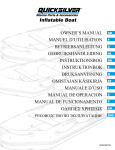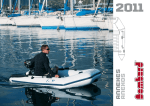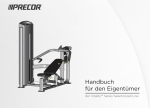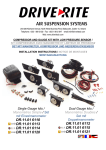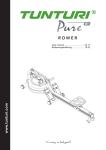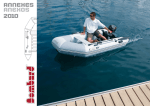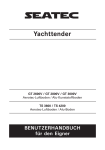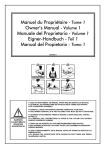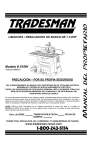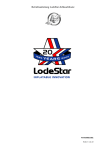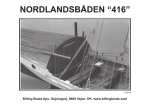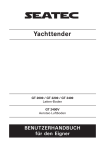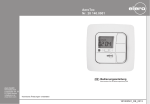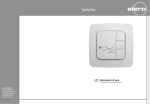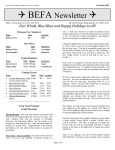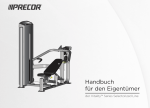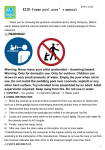Download Z O O M - NAUTIVELA
Transcript
Tome 2 - Volume 2 Teil 2 - Tomo 2 ZOOM BY ZODIAC 230 Roll Up 260 Aero 260 Solid – 310 Solid 350 SP ALU – 400 SP ALU – 450 SP ALU Code ZT03762 édition 11 LIRE ATTENTIVEMENT CE MANUEL AVANT LA MISE EN SERVICE. CAREFULLY READ THIS MANUAL BEFORE OPERATING. LEGGERE ATTENTAMENTE PRIMA DE INIZIARE IL MONTAGGIO . VOR INBETRIEBNAHME IHRES VORLIEGENDES HANDBUCH AUFMERKSAM LESEN. LEER CUIDADOSAMENTE ESTE MANUAL ANTES DE PONER EN SERVICIO. Tome 2 - Volume 2 Teil 2 - Tomo 2 ZOOM BY ZODIAC 230 Roll Up 260 Aero 260 Solid – 310 Solid 350 SP ALU – 400 SP ALU – 450 SP ALU Code ZT03762 édition 11 F R A N C A I S ZOOM by zodiac 230 Roll Up 260 Aero 260 Solid – 310 Solid 350 SP ALU – 400 SP ALU – 450 SP ALU Tome 2 1 / 12 TOME 2 CARACTERISTIQUES TECHNIQUES - PROCEDURE DE MONTAGE z LISEZ ATTENTIVEMENT CE MANUEL AVANT MISE EN SERVICE DU BATEAU. AVERTISSEMENT z LE MANUEL DU PROPRIETAIRE SE DIVISE EN DEUX TOMES QUI DOIVENT ETRE CONSERVES ENSEMBLE. LE MANUEL DU PROPRIETAIRE SE DIVISE EN DEUX TOMES: NOTE : - LE TOME 1 TRAITE D’UNE MANIERE GENERALE DES PRECAUTIONS D’USAGE ET DES RECOMMANDATIONS A RESPECTER A BORD DU BATEAU ET SUR L’EAU. - LE TOME 2 TRAITE PLUS PARTICULIEREMENT DES CARACTERISTIQUES TECHNIQUES ET DU MONTAGE DU BATEAU ET DE SON EQUIPEMENT. SOMMAIRE Page Page ÖLes étapes de la mise en service du bateau 3 ÖPression 10 ÖInventaire à l'ouverture de l’emballage 3 ÖMontage de l’équipement 11 ÖDégonflage / pliage du bateau 12 ÖMontage du bateau ÖLe système de gonflage ÖGonflage du bateau 4-6 7 8-9 2 / 12 ÖDescription générale I - VI LES GRANDES ETAPES DE LA MISE EN SERVICE DU BATEAU La procédure de montage du bateau suit un ordre que nous vous engageons à respecter. Procédez étape par étape en vous reportant à chaque fois aux pages indiquées pour les explications de procédure. PROCEDURE PAGE SECTION 1. faites l’inventaire des éléments qui composent votre bateau, et apprenez à les reconnaître 3 INVENTAIRE A L’OUVERTURE I - VI DESCRIPTION 7 SYSTEME DE GONFLAGE 8-9 GONFLAGE DU BATEAU 2. activez les valves en position de gonflage Et gonflez légèrement le flotteur 3. ZOOM Solid et Alu : Assemblez le plancher les longerons ZOOM Roll Up : Montez les lattes ZOOM AERO : Gonflez le plancher. et 5-6 MONTAGE DU BATEAU 4 4 4. Installez le banc de nage. 5. terminez le gonflage du bateau aux pressions d’utilisation 6. Mettez en place les avirons 11 MONTAGE DE L’EQUIPEMENT 8-9 GONFLAGE DU BATEAU 10 PRESSION 11 MONTAGE DE L’EQUIPEMENT INVENTAIRE A L'OUVERTURE DE L'EMBALLAGE NE PAS UTILISER D'OUTIL TRANCHANT (CUTTER, COUTEAU, ETC.) ATTENTION L'emballage de votre bateau contient 1 flotteur + : ZOOM by Zodiac Lattes Plancher contreplaqué marine Plancher aluminium Plancher gonflable AEROTEC Quille gonflable Longerons 230 Roll Up 260 Aero 260 - 310 Solid 350 SP Alu 400 – 450 SP Alu X X X X X X X X 2 1 1 1 1 2 2 2 Pagaies 1 1 1 2 1 2 1 2 1 2 X X X X Equipement standard Avirons Gonfleur à pied Banc de nage amovible Sac de transport Mallette de réparation Manuel du propriétaire 2 1 1 1 1 2 2 1 1 1 1 2 Vous pouvez équiper votre bateau d’accessoires en option (roues de transport, échelle de bain, anneaux de levage etc ...). Demandez à votre agent de vous conseiller. SI VOUS SOUHAITEZ AJOUTER DES ANNEAUX DE LEVAGE (POUR LA MISE SOUS BOSSOIRS), VOUS DEVEZ IMPERATIVEMENT LES NOTE : FIXER SUR LES FLOTTEURS ET NON SUR LE PLANCHER (SAUF 400SR, VOIR « EMPLACEMENT ACCESSOIRES »). 3 / 12 F R A N C A I S MONTAGE DU BATEAU PROCEDEZ AU MONTAGE SUR UN SOL PROPRE ET LISSE. SI LE BATEAU EST STOCKE A UNE TEMPERATURE INFERIEURE A 0°C, LAISSEZ LE 12 H DANS UN LIEU TEMPERE (20°C) AVANT DE LE DEPLIER. ZOOM AVEC PLANCHER À LATTES : Si les lattes ne sont pas déjà montées, le bateau étant dégonflé, enfilez les lattes dans leurs goussets en commençant par la latte le plus près du tableau arrière. Si l’insertion d’une latte est difficile, lubrifiez celle-ci avec du savon liquide. ZOOM AERO: PLANCHER GONFLABLE AERO plancher Haute Pression DEGONFLE DEMONTAGE/ ENTRETIEN DU PLANCHER GONFLABLE HAUTE PRESSION Au pliage, nous vous conseillons de laisser le plancher à poste dans le bateau. Cependant, pour nettoyer le fond du bateau où le sable et autres détritus peuvent s’accumuler, il peut être utile de retirer le plancher gonflable. Procédez alors de la manière suivante: 1. DEMONTAGE: Dégonflez le flotteur et le plancher. Faites coulisser la ralingue du plancher hors de ses taquets (procédure inverse de celle du montage). 2. ENTRETIEN: Regonflez légèrement le bateau avant de rincez au jet entre le flotteur et le fond, puis levez le nez du bateau pour évacuer l’eau. Répétez l’opération jusqu’à ce que tout le sable ou détritus soient évacués. 4 / 12 MONTAGE DU BATEAU MISE EN PLACE DU PLANCHER CONTREPLAQUE MARINE OU DU PLANCHER ALUMINIUM • Mettez de la fécule de pomme de terre dans la cornière (bande renforcée située entre le flotteur et le fond, voir figure 1.B) pour faciliter la mise en place des éléments de plancher. ATTENTION: JAMAIS DE TALC • Repérez bien les éléments et leur sens: - Le plancher est composé de trois éléments de plancher et deux volets avant [fg 1]. - Repérez l'ordre des éléments. - Les volets ont un côté endroit et un côté envers. Repérez-vous aux rayures des profilés aluminium de jonction; elles doivent être apparents une fois les éléments montés. Les renforts doivent toujours etre sur le dessus. 1. Gonflez légèrement le flotteur (cela facilitera la mise en place des éléments de plancher). 2. Introduisez le volet avant (1) dans la cornière. 3. Introduisez l'élément arrière (5) contre le tableau (6) comme indiqué figure 1. 4. Emboîtez les éléments les uns dans les autres [fig.1]. 5. Mettez en "toit" les éléments de plancher (3) et (4) [fig 1 et 2]. 6. Vérifiez que l'ensemble est bien aligné [fig 4]. 7. Aplatissez le toit en montant dans le bateau et en tirant les saisines vers le haut pour éviter de coincer le tissu [fig. 2]. 8. Vérifiez que le plancher est bien positionné dans la cornière. 9. Installez les longerons comme cela est indiqué ci-dessous: MISE EN PLACE DES LONGERONS : Les longerons permettent de verrouiller le plancher et d’en rigidifier la structure, élément essentiel pour la bonne navigabilité du bateau. 1. Pour faciliter la mise en place du premier longeron (7), glissez le second longeron sous le fond du bateau à 20 centimètres du bord environ [fig. 3]. NE METTEZ PAS LE LONGERON SOUS LE FOND DU BATEAU AVANT D’AVOIR APLATI LE PLANCHER : LE CHOC POURRAIT LES ENDOMMAGER. 2. Positionnez les longerons le long du plancher; le repérage du longeron (8) doit rester sur le dessus [fig. 3]. 3. Assurez-vous que les longerons sont correctement positionnés entre les butoirs (9) des éléments 3 et 5 [fig. 4]. 4. Faites pivoter les longerons sur eux-mêmes de façon à ce qu’ils prennent en « sandwich » l’épaisseur du plancher et se positionnent correctement dans le creux de la cornière [fig. 3 et 4]. 5. La structure auto-serrante du plancher facilitera la mise en place finale des longerons lors du gonflage du flotteur. 5 / 12 F R A N C A I S MONTAGE DU BATEAU fig 1-A fig 1-B 1 2 3 4 5 6 a- plancher c- cornière b- flotteur d- fond a c b d fig 2 1 2 3 fig 3 1 8 7 6 / 12 2 3 4 4 fig 4 5 7 5 9 6 F R A N C A I S LE SYSTEME DE GONFLAGE Le système de gonflage comprend: LE GONFLEUR 2 POSITIONS POUR MODELES A PLANCHER GONFLABLE AEROTEC B A En position A : Bouchon inséré. Le gonfleur développe un débit maximal mais une faible pression: position pour mettre en forme rapidement tous les éléments gonflables. En position B : Bouchon retiré. Le gonfleur développe un débit inférieur à la position A, mais permet d’atteindre avec le même effort une pression supérieure C Ne jamais dépasser la pression autorisée. En position C : permet de dégonfler LE GONFLEUR STANDARD (POUR MODELES A LATTES OU A PLANCHER RIGIDE) A A. embout du tuyau B. embase du tuyau C. orifice de gonflage B C 1/4 LES VALVES. Pour changer de position en position de gonflage en position de dégonflage Poussez La membrane est fermée, le poussoir en position haute La membrane est ouverte, le poussoir en position basse 7 / 12 GONFLAGE DU BATEAU (MODELES A LATTES ou A PLANCHER RIGIDE) Activez toutes les valves en position gonflage. Fixez l’embase du tuyau à l’orifice de gonflage du gonfleur. Pour bien gonfler votre bateau, il faut que le gonfleur ait une bonne assise sur le sol. Le bateau se gonfle rapidement si le gonfleur est actionné en souplesse et sans précipitation. NE PAS UTILISER DE COMPRESSEUR OU DE BOUTEILLE A AIR COMPRIME. ATTENTION Vous pouvez utiliser le gonfleur électrique ACCESS en vente chez votre agent. GONFLAGE DU FLOTTEUR Procédez au gonflage du flotteur en équilibrant les pressions entre les différents compartiments, jusqu'à ce que les cloisons (a) ne soient plus visibles (voir chapitre « Pression »). NE JAMAIS METTRE UN COMPARTIMENT SOUS PRESSION LES AUTRES ETANT COMPLETEMENT DEGONFLES 1 2 a 100 % 50 % 0% 50 % 100 % 100 % 0% 50 % 100 % GONFLAGE DE LA QUILLE • Une fois le plancher monté, procédez au gonflage de la quille (voir chapitre PRESSION). Le gonflage est terminé: vissez les bouchons des valves de gonflement. NOTE : Il est normal de constater une légère fuite d’air avant le vissage du bouchon de valve. SEULS LES BOUCHONS ASSURENT L'ETANCHEITE FINALE. 8 / 12 F R A N C A I S GONFLAGE DU BATEAU (AVEC PLANCHER GONFLABLE AERO) Activez toutes les valves en position gonflage. Fixez l’embase du tuyau à l’orifice de gonflage du gonfleur. Pour bien gonfler votre bateau, il faut que le gonfleur ait une bonne assise sur le sol. Le bateau se gonfle rapidement si le gonfleur est actionné en souplesse et sans précipitation. NE PAS UTILISER DE COMPRESSEUR OU DE BOUTEILLE À AIR COMPRIME. ATTENTION A - GONFLEZ LE PLANCHER AERO (voir chapitre PRESSION). UTILISEZ LE GONFLEUR 2 POSITIONS 1. Insérez le tuyau comme indiqué dans la figure A et commencez à gonfler en laissant le bouchon inséré. Gonflez jusqu’à ce que le maniement devienne dur. 2. Puis enlevez le bouchon. Terminez le gonflage en position B jusqu’à atteindre la pression recommandée (voir chapitre PRESSION). 3. B - GONFLEZ LE FLOTTEUR PRINCIPAL ET LA QUILLE (voir chapitre PRESSION). PRESSION MAXIMUM FLOTTEUR ET QUILLE (voir chapitre PRESSION). ATTENTION N’UTILISEZ JAMAIS LA POSITION B DU GONFLEUR POUR GONFLER LE FLOTTEUR OU LA QUILLE, VOUS RISQUERIEZ L’ECLATEMENT. 1. Gonflez le flotteur avec le soufflet en position A (bouchon inséré), et gonflez jusqu’à atteindre la pression recommandée (240 mb) en équilibrant les pressions entre les différents compartiments, jusqu'à ce que les cloisons (a) ne soient plus visibles. (voir chapitre PRESSION). 2. Gonflez ensuite la quille selon le même procédé. (voir chapitre PRESSION). NE JAMAIS METTRE UN COMPARTIMENT SOUS PRESSION LES AUTRES ETANT COMPLETEMENT DEGONFLES 1 2 a 100 % 50 % 100 % 0% 50 % 100 % 0% 50 % 100 % Le gonflage est terminé: vissez les bouchons des valves de gonflement. NOTE : Il est normal de constater une légère fuite d’air avant le vissage du bouchon de valve. SEULS LES BOUCHONS ASSURENT L'ETANCHEITE FINALE. 9 / 12 PRESSION La pression d’utilisation pour le flotteur et la quille est de 240 mb (3,48 PSI); celle du fond gonflable Aerotec est de 600 mb (8.5 PSI). Si votre bateau n’est pas équipé d’un indicateur de pression ACCESS, nous vous recommandons de vous en procurer un chez votre agent. Il vous permettra une lecture rapide et efficace pendant le gonflage. Sans indicateur de pression, arrêtez de gonfler dès que le flotteur est suffisamment ferme pour que l’on ne puisse plus couder à la main les cônes à l’arrière du flotteur. La température ambiante de l’air ou de l’eau influe proportionnellement sur le niveau de la pression interne du flotteur: Température ambiante +1°C -1°C pression interne du flotteur +4 mb / 0,06 PSI -4 mb / 0,06 PSI Aussi, est-il important de savoir anticiper : Vérifiez et ajustez la pression des compartiments gonflables (en regonflant ou en dégonflant selon le cas) en fonction des variations de température (surtout lorsque les écarts de température sont importants entre le matin et le soir dans les zones particulièrement chaudes) et assurez vous que la pression ne s’écarte pas de la zone de pression recommandée (de 220 à 270 mb / zone verte). RISQUE DE SOUS-PRESSION EXEMPLE: Votre bateau est exposé sur la plage en plein soleil (température=50°C) à la pression recommandée (240 mb/3,48 PSI). Lorsque vous le mettrez à l’eau (température=20°C), la température et la pression interne des compartiments gonflables vont conjointement baisser (jusqu’à 120 mb) et IL VOUS FAUDRA ALORS REGONFLER jusqu’à regagner les millibars perdus à cause de l’écart de température entre l’air ambiant et l’eau. Ainsi il est normal de constater une diminution de pression en fin de journée lorsque la température extérieure baisse. NOTE : Sous-gonflé, votre bateau manque de rigidité en navigation, offre de mauvaises performances et risque de vieillir prématurément. RISQUE DE SURPRESSION EXEMPLE: Votre bateau est gonflé à sa pression recommandée (240 mb/3,48 PSI) en début ou fin de journée (température extérieure basse=10°C). Plus tard dans la journée, votre bateau est exposé en plein soleil sur la plage ou sur le pont d’un yacht (température=50°C). La température intérieure des compartiments gonflables peut alors s’élever et atteindre jusqu’à 70°C (flotteurs de couleur foncée notamment) entraînant un doublement de la pression de départ (480 mb). IL VOUS FAUDRA ALORS DEGONFLER afin de revenir à la pression recommandée. SI VOTRE BATEAU EST TROP GONFLE, LA PRESSION SOLLICITE DE FAÇON ATTENTION ANORMALE LA STRUCTURE ENTRAINER UNE RUPTURE D’ASSEMBLAGE. EN CAS DE SURPRESSION Libérez de l’air en appuyant sur le poussoir de la valve 10 / 12 GONFLABLE POUVANT MONTAGE DE L'EQUIPEMENT LES AVIRONS 6 1. pale 2. manche d’aviron 3. tolet 4. rainure 5. dame de nage 6. molette 4 5 Pour assembler les avirons, Emboîtez le manche d’aviron dans la pale et Tournez jusqu’à ce que le cran d’arrêt soit enclenché. Pour positionner les avirons sur les dames de nage: (Attention, les avirons babord et tribord sont différents; ne les intervertissez pas.) : A. Introduisez le tolet d’aviron dans le trou correspondant de la dame de nage. x Quand la pale de l’aviron est dirigée vers l’intérieur du bateau, x La rainure du tolet doit impérativement être dirigée vers l’arrière du bateau. B. Tournez de 180 degrés pour ramer. Vérifiez que l’aviron est bien bloqué dans la dame de nage. C. En position de repos, Ramenez la pale vers l’arrière du flotteur et engagez le manche dans le repose avron situé à l’arrière du flotteur. A B C LE BANC DE NAGE Installez le banc de nage avant de terminer le gonflage. 11 / 12 F R A N C A I S DEGONFLAGE / PLIAGE DU BATEAU 1. Dégonflez le bateau et remettez les protections des valves pour le stockage 2. Retirez les avirons (selon la procédure inverse du montage) et les éventuels équipements optionnels. 3. Retirez le plancher (ZOOM 260S, 310S, 350 S) selon la procédure inverse de celle du montage. Pour les ZOOM équipés de lattes ou d’un plancher gonflable, il est inutile de les retirer lors du pliage. 4. Retirez les bouchons des vide-vite, et videz le bateau de l’eau qui pourrait s’y trouver (en cas de stockage prolongé, assurez-vous que le bateau soit bien sec avant de le plier). 5. Repliez les 2 côtés du flotteur vers l'intérieur du bateau (A), amenez les cônes contre le tableau (B), puis enroulez le bateau sur lui-même, autour du tableau (C). Recommencez l’opération si vous constatez qu’il reste de l’air dans les flotteurs. A flotteur B fond flotteur dégonflé C Rangez le bateau dans son sac. Rangez le plancher rigide dans son sac (pour certains modèles à plancher bois ou aluminium). 12 / 12 E N G L I S H ZOOM by zodiac 230 Roll Up 260 Aero 260 Solid – 310 Solid 350 SP ALU – 400 SP ALU – 450 SP ALU Volume 2 1 / 12 VOLUME 2 TECHNICAL FEATURES - ASSEMBLY PROCEDURE z READ THIS MANUAL CAREFULLY BEFORE USING YOUR BOAT. WARNING z THE OWNER'S MANUAL COMES IN TWO VOLUMES THAT SHOULD BE KEPT TOGETHER. THE OWNER'S MANUAL IS DIVIDED INTO TWO VOLUMES: NOTE: - VOLUME 1 DEALS IN GENERAL WITH THE OPERATING PRECAUTIONS AND SAFETY RECOMMENDATIONS TO BE OBSERVED ONBOARD THE BOAT AND ON THE WATER. - VOLUME 2 DEALS WITH TECHNICAL SPECIFICATIONS AND ASSEMBLY PROCEDURE OF THE BOAT AND ITS EQUIPMENT. TABLE OF CONTENTS Page Page ÖAssembly procedure 3 ÖPressure 10 ÖCheck on unpacking 3 ÖEquipment assembly 11 ÖDeflating / Folding the boat 12 ÖBoat assembly 4-6 ÖInflation system 7 ÖInflating the boat 8-9 2 / 12 ÖGeneral description I - VI ASSEMBLY PROCEDURE The boat assembly procedure follows an order you must respect. Proceed step by step, referring each time to the pages indicated for explanations. PROCEDURE PAGE SECTION 1. Make an inventory of the parts of your boat and get to know them. 3 CHECK ON UNPACKING I - VI DESCRIPTION 7 INFLATION SYSTEM 8-9 INFLATING THE BOAT 2. Activate the valves in the inflating position Slightly inflate the main buoyancy tube 3. ZOOM S: Assemble the floorboard stringers ZOOM 230: Install the battens ZOOM AEROTEC: Inflate the floorboard. and the 5-6 4. Install the thwart. 5. fully inflate the boat to the correct pressure pressure. 6. Install the oars 4 4 BOAT ASSEMBLY 11 EQUIPMENT ASSEMBLY 8-9 INFLATING THE BOAT 10 PRESSURE 11 EQUIPMENT ASSEMBLY CHECK ON UNPACKING DO NOT USE A SHARP TOOL (CUTTER, KNIFE, ETC.) CAUTION The pack must contain 1 buoyancy tube +: ZOOM by Zodiac Battens Navy plywood floorboard Aluminium floorboard Aerotec inflatable floorboard Inflatable keel Stringers 230 Roll Up 260 Aero 260 - 310 Solid 350 SP Alu 400 – 450 SP Alu X X X X X X X X 2 1 1 1 1 2 2 1 1 2 1 2 2 paddles 1 1 2 1 2 X X X X STANDARD EQUIPMENT Oars Inflator Removable thwart Bag Repair kit Owner's manual 2 1 1 1 1 2 2 1 1 1 1 2 You can equip your boat with many optional accessories (transportation wheels, ladder, lifting rings etc.). Ask your dealer to advise you. IF YOU WANT TO ADD LIFTING RINGS (FOR DAVIT HANDLING), YOU MUST SECURE THEM TO THE BUOYANCY TUBES, NOT ON THE NOTE: FLOORBOARDS (EXCEPT FOR THE ZOOM 400 SR, SEE "LOCATION OF ACCESSORIES"). 3 / 12 E N G L I S H BOAT ASSEMBLY CHOOSE A SMOOTH, CLEAN SURFACE. IF THE BUOYANCY TUBE WAS STORED AT A TEMPERATURE BELOW 0°C / 32°F, LEAVE IT AT 20°C / 68°F FOR 12 HOURS BEFORE UNFOLDING. ZOOM 230 ROLL UP – BATTEN FLOORBOARD: If the battens are not installed, with the boat deflated, insert the battens in their brackets beginning with the batten nearest the aft transom. If a batten is difficult to insert, lubricate it with liquid soap. ZOOM AERO: - INFLATABLE FLOORBOARD high pressure floorboard DEFLATED HIGH PRESSURE FLOORBOARD DISASSEMBLY/MAINTENANCE When folding the boat, we recommend you leave the floorboard in place in the boat. However, to clean the bottom of the boat where sand and other waste may accumulate, it may be useful to remove the inflatable floorboard. Follow this procedure: 1. DISASSEMBLY: Deflate the buoyancy tube and the floorboard. Slide the floorboard bolt rope out of its cleats (following the assembly procedure in the reverse order). 2. MAINTENANCE: Slightly reinflate the boat and hose down the area between the buoyancy float and the bottom, and then lift the bow of the boat to let the water run out. Repeat the operation until all the sand or waste and has been removed. 4 / 12 BOAT ASSEMBLY INSTALLING THE NAVY PLYWOOD FLOORBOARD (ZOOM S) OR THE ALUMINIUM FLOORBOARD (ZOOM SP ALU). • Sprinkle some starch in the angle (reinforced strip between the buoyancy tube and the bottom, see figure 1.B) to facilitate the fitting of the floorboard. CAUTION: NEVER USE TALCUM POWDER • Make sure you identify the parts and direction in which they fit: - The floorboard consists of 3 main sections and 2 sections in the bow [fig. 1]. - Identify the order of the items. - The bow sections have an upside and a downside. The aluminium junction sections are striped. The stripes should be visible once the parts are assembled. The stiffeners must always be on top. 1. Slightly inflate the buoyancy tube (this will make it easier to install the floorboard items). 2. Insert the bow section (1) into the bow angle. 3. Insert the rear section (5) against the transom (6) as show in fig 1. 4. Fit all the sections together [fig 1]. 5. Position sections (3) and (4) as an apex (in a tent-like position) [fig 1 and 2]. 6. Check that all sections are correctly aligned [fig 4]. 7. Flatten the apex by standing on it (in the boat) and pulling the lifelines to prevent the fabric from being pinched [fig. 2]. 8. Check that the floorboard is correctly fitted in the angles. 9. Install the stringers (see instructions bellow). INSTALLING THE STRINGERS : The stringers are essential for correct operation of the boat: they lock the floorboard together and rigidify its structure. 1. To facilitate the fitting of the first stringer (7), slide the second stringer under the bottom of the boat at about 20 cm from the side [fig. 3-a]. DO NOT PUT THE STRINGER IN POSITION UNDER THE BOAT UNTIL THE FLOOR IS FLATTENED: THEY COULD BE DAMAGED BY THE SHOCK. 2. Position the stringers on the edge of the floorboard. The reference mark on the stringer (8) must remain on top [fig. 3]. 3. Fit correctly the stringers between the two buffers (9) of sections 3 and 5 [fig. 4]. 4. Rotate the stringers so that they press against the floorboard and fit correctly in the angle [fig. 3 and 4]. 5. Because of the self-locking system of the floorboard, the stringers will fit into place once the buoyancy tube is inflated. 5 / 12 E N G L I S H BOAT ASSEMBLY fig 1-A fig 1-B 1 2 3 4 5 6 abcd- floorboard buoyancy tube bow angle bottom a c b d fig 2 1 2 fig 3 3 4 5 6 fig 4 1 8 7 6 / 12 2 3 4 5 7 9 INFLATION SYSTEM The inflation system is composed of: THE HIGH PRESSURE FOOT-PUMP FOR MODELS WITH AN INFLATABLE AEROTEC FLOOR B A Position A The pump has maximum flow but low pressure: this position is used to give shape rapidly to all inflatable parts of the boat. Position B The flow is inferior to position A, but provides pressure that is superior, with the same effort. C Position C To deflate. Insert the tube as indicated in figure C and pump normally. THE STANDARD INFLATOR – EXCEPT FOR AEROTEC MODELS. A A. tube nozzle B. tube connector C. inflation port B C 1/4 THE VALVES . To change the position: Push / Push Inflation position Deflation position diaphragm closed, the inner button springs upwards diaphragm open, the inner button goes down 7 / 12 E N G L I S H INFLATING A NON AEROTEC BOAT (WITH BATTENS OR RIGID FLOOR) Activate all valves in the inflation position. Attach the hose connector to the inflator inflation port. To inflate your boat properly, the inflator should be correctly placed on the ground. The boat inflates rapidly if the inflator is used smoothly and without haste. DO NOT USE A COMPRESSOR OR COMPRESSED AIR CYLINDER. CAUTION You can us the electrical air pump ACCESS (ask your Dealer). INFLATING THE BUOYANCY CHAMBER (see "PRESSURE" section) • Inflate the buoyancy mechanism, balancing the pressure between the different compartments until the partitions (a) are no longer visible (see "PRESSURE" section) Never pressurise a compartment when the others are completely deflated a 1 2 INFLATING THE KEEL (see "PRESSURE" section) • Once the floorboard is installed, start inflation (see "PRESSURE" section) Inflating is complete: screw on the inflating valve caps. NOTE: A slight air leak is normal before the valve cap is screwed on ONLY THE VALVE CAPS CAN ENSURE FINAL AIR TIGHTNESS. 8 / 12 INFLATING A ZOOM AERO BOAT Activate all valves in the inflation position. Attach the hose connector to the inflator inflation port. To inflate your boat properly, the inflator should be correctly placed on the ground. The boat inflates rapidly if the inflator is used smoothly and without haste. DO NOT USE A COMPRESSOR OR COMPRESSED AIR CYLINDER. CAUTION A - INFLATE THE HIGH PRESSURE FLOORBOARD (AEROTECH MODELS ONLY) 1. Inflate Insert the pipe as shown in figure A (with the cap inserted) and begin to inflate leaving the cap inserted. The inflator uses its full capacity. Inflate until hard. 2. Then remove the cap. The pump automatically uses the smallest chamber needed to provide the High Pressure bottom inflation pressure without undue force. Complete inflation in position B until the recommended pressure is reached (see "PRESSURE" section) B - INFLATE THE MAIN BUOYANCY TUBE AND THEN THE KEEL NEVER USE POSITION B TO INFLATE THE BUOYANCY TUBE OR THE KEEL: BURSTING HAZARD. CAUTION Inflate the buoyancy tube Insert the pipe as shown in figure A (with the cap inserted) and begin to inflate leaving the cap inserted. The inflator uses its full capacity and allows the recommended pressure (see "PRESSURE" section)) to be achieved. Make sure that the pressures between the compartments are equalized, until the partitions (a) can no longer be seen. Never pressurise a compartment when the others are completely deflated a 1 2 Then inflate the keel (see "PRESSURE" section) Inflating is complete: screw on the inflating valve caps. NOTE: A slight air leak is normal before the valve cap is screwed on ONLY THE VALVE CAPS CAN ENSURE FINAL AIR TIGHTNESS. 9 / 12 E N G L I S H PRESSURE The correct pressure for the buoyancy tube and the keel is 240 mb (3.48 PSI) and the correct pressure for the Aerotech inflatable bottom is 600 mb (8.5 PSI). If your boat is not equipped with an ACCESS pressure indicator, we recommend that you purchase one from your dealer. This will permit a quick and efficient control of the pressure during inflation. Without a pressure indicator, stop inflating when buoyancy tube is sufficiently hard so that the cones on the aft section of the buoyancy tube cannot be bent by hand. The ambient temperature of the air or water proportionately influences the level of internal pressure in the buoyancy chamber Ambient temperature +1°C -1°C Buoyancy tube internal pressure +4 mb / 0.06 PSI -4 mb / 0.06 PSI Thus, it is important to anticipate: Check and adjust the pressure of the inflatable compartments (inflating or deflating according to the case) according to the temperature variations (especially when there is a considerable difference in temperature between morning and evening in particularly hot areas) and make sure that the pressure remains within the recommended pressure range (from 220 to 270 mb / green sector). RISK OF UNDERPRESSURE EXAMPLE: Your boat is exposed to direct sunlight on the beach (temperature=50°C) at the recommended pressure (240 mb/3.48 PSI). When you launch it (temperature=20°C), the temperature and internal pressure of the inflatable compartments will drop simultaneously (up to 120 mb) and YOU WILL THEN NEED TO REINFLATE until you regain the millibars lost due to the difference between the ambient air and water temperatures. A drop in pressure at the end of the day, when the outside temperature is dropping, is normal. NOTE: Proper inflation is critical to the performance of the boat. It is the pressure in the tubes that gives your boat the necessary rigidity to perform well. Underinflation causes improper flexing of the tubes which will cause early aging. RISK OF OVERPRESSURE EXAMPLE: Your boat is inflated to its recommended pressure (240 mb/3.48 PSI) at the beginning or end of the day (low outside temperature = 10°C). Later in the day, your boat is exposed in the sun on the beach or on a yacht deck (temperature = 50°C). The temperature inside the inflatable compartments may rise to 70°C (particularly for dark buoyancy chambers), doubling the initial pressure (480 mb). YOU WILL THEN NEED TO DEFLATE the boat to return to the recommended pressure. IF YOUR BOAT IS OVERINFLATED, THERE WILL BE UNDUE PRESSURE ON THE INFLATABLE STRUCTURE THAT MAY RUPTURE IT. CAUTION IN THE EVENT OF OVERPRESSURE Deflate by pressing the spring loaded button. 10 / 12 EQUIPMENT ASSEMBLY OARS 6 1.blade 2.oar shaft 3.rowlock 4.groove 5.rowlock socket 6.thumbwheel 4 5 To assemble the oars, insert the oar shaft into the blade and rotate until the stop notch is engaged. To position the oars in the rowlocks: (Caution, the port and starboard oars are different; do not reverse them): A.Insert the rowlock into the corresponding hole in the rowlock socket. x When the oar blade is pointing inboard, x The rowlock groove must point aftwards. B. Rotate through 180 degrees to row. Make sure that the oar is securely locked in the rowlock socket. C. Bring the blade towards the aft of the buoyancy tube and engage the shaft in the attaching mount located aft of the buoyancy tube. A B C THWART Install the thwart before completing inflation. 11 / 12 E N G L I S H DEFLATING / FOLDING THE BOAT 1. 2. 3. 4. Deflate the boat. Replace the valve protections. Remove oars and equipment. Remove the floorboard (For Zoom S only - for models with a slatted floor, It is not necessary to remove the slats to fold the boat). 5. Empty the boat of all water and sand by opening the self-bailers, dry it. 6. Fold in the 2 sides of the main buoyancy tube (A), fold the cones onto the transom, then roll up the boat around the transom (C). Start again if you feel there is still some air left in the tubes. A buoyancy tube B floor tube deflated C Stow the boat in its bag. For some models with wooden or aluminium floorboard, stow the floorboard in its bag. 12 / 12 I T A L I A N O ZOOM by zodiac 230 Roll Up 260 Aero 260 Solid – 310 Solid 350 SP ALU – 400 SP ALU – 450 SP ALU Tomo 2 1 / 12 Volume 2 CARATTERISTICHE TECNICHE – PROCEDURE DI MONTAGGIO z LEGGERE ATTENTAMENTE IL PRESENTE MANUALE PRIMA DI UTILIZZARE L’IMBARCAZIONE. AVVERTENZA z IL MANUALE DEL PROPRIETARIO SI COMPONE DI DUE TOMI CHE DEVONO ESSERE CONSERVATI INSIEME. IL MANUALE DEL PROPRIETARIO SI COMPONE DI DUE VOLUMI: NOTA: - VOLUME 1 RIGUARDA IN GENERALE LE PRECAUZIONI D’USO E LE RACCOMANDAZIONI DA RISPETTARE A BORDO DELL’IMBARCAZIONE E DURANTE LA NAVIGAZIONE. - VOLUME 2 RIGUARDA PIÙ PARTICOLARMENTE LE CARATTERISTICHE TECNICHE E DI MONTAGGIO DELL’IMBARCAZIONE E DEL SUO EQUIPAGGIAMENTO. INDICE PAG. PAG. ÖProcedura generale per la messa in servizio dell’imbarcazione 3 ÖPressione 10 ÖInventario all’apertura dell’imballaggio 3 ÖAssemblaggio dell’equipaggiamento 11 ÖSgonfiaggio / piegatura dell’imbarcazione 12 ÖMontaggio dell’imbarcazione ÖIl sistema di gonfiaggio ÖGonfiaggio dell’imbarcazione 4-6 7 8-9 2 / 12 ÖDescrizione generale I - VI PROCEDURA GENERALE PER LA MESSA IN SERVIZIO DELL’IMBARCAZIONE La procedura di montaggio dell’imbarcazione segue un ordine preciso che si consiglia caldamente di rispettare. Procedere tappa dopo tappa, consultando ogni volta le pagine indicate per la spiegazione della procedura. PROCEDURA PAG. SEZIONE 1. Effettuare l’inventario degli elementi che compongono l’imbarcazione e imparare a riconoscerli. 3 INVENTARIO ALL’APERTURA I - VI DESCRIZIONE 7 SISTEMA DI GONFIAGGIO 8-9 GONFIAGGIO DEL BATTELLO 2. Portare le valvole in posizione di gonfiaggio Gonfiare leggermente il galleggiante. 3. ZOOM Solid / SP Alu: Assemblare il piano e i longheroni. ZOOM Roll Up : Montare le doghe. ZOOM Aero: Gonfiare il piano. 5-6 4 4 MONTAGGIO DEL BATTELLO I 4. Installare il banco di voga. MONTAGGIO 11 5. Terminare il gonfiaggio dell’imbarcazione alle pressioni di utilizzo. 6. Collocare i remi. DELL’APPARECCHIATURA 8-9 GONFIAGGIO DEL BATTELLO 10 PRESSIONE MONTAGGIO 11 DELL’APPARECCHIATURA INVENTARIO ALL’APERTURA DELL’IMBALLAGGIO NON UTILIZZARE STRUMENTI TAGLIENTI (TAGLIERINE, COLTELLI, ECC.) ATTENZIONE L’imballaggio dell’imbarcazione contiene 1 galleggiante e i seguenti elementi: ZOOM by Zodiac Doghe Piano con pannello compensato per uso esterno Piano in alluminio Piano gonfiabile AEROTEC Chiglia gonfiabile Longheroni 230 Roll Up 260 Aero 260 - 310 Solid 350 SP Alu 400 – 450 SP Alu X X X X X X X X 2 1 1 1 1 2 2 1 1 2 1 2 2 pagaies 1 1 2 1 2 X X X X Equipaggiamento standard Remi Pompa di gonfiaggio Banco di voga amovible Sacca di trasporto Valigetta per le riparazioni Manuale dell’utente 2 1 1 1 1 2 2 1 1 1 1 2 E’ possibile aggiungere all’imbarcazione degli accessori supplementari (ruote di trasporto, scaletta, anelli di sollevamento, ecc.). Chiedere consiglio al proprio rivenditore. IN CASO DI AGGIUNTA DI ANELLI DI SOLLEVAMENTO (PER LA MESSA SOTTO PARANCHI) E’ FONDAMENTALE CHE ESSI VENGANO NOTA: FISSATI SUI GALLEGGIANTI E NON SUL PIANO (TRANNE 400SR, VEDERE “POSIZIONAMENTO ACCESSORI”). 3 / 12 T A L I A N O MONTAGGIO DELL’IMBARCAZIONE PROCEDERE AL MONTAGGIO SU UN SUPPORTO PULITO E LISCIO. SE IL TUBOLARE È STATO CONSERVATO A UNA TEMPERATURA INFERIORE A 0°C, LASCIARLO PER 12 ORE IN UN LUOGO TEMPERATO (20°C) PRIMA DI PROCEDERE AL MONTAGGIO. ZOOM – PIANO CON LE DOGHE Con l’imbarcazione sgonfia, infilare le doghe nei loro supporti iniziando con la doga più vicina al quadro di poppa. Se l’inserimento di una doga risulta difficile, lubrificarla con del sapone liquido. ZOOM AERO: PIANO GONFIABILE AEROTEC Piano ad Alta Pressione SGONFIO SMONTAGGIO / MANUTENZIONE DEL PIANO GONFIABILE AD ALTA PRESSIONE Quando lo si ripiega, si consiglia di lasciare il piano al proprio posto nell’imbarcazione. Per pulire il fondo dell’imbarcazione dove possono accumularsi sabbia e altri detriti, può in ogni caso essere utile togliere il piano gonfiabile. Procedere quindi nel modo che segue: 1. SMONTAGGIO: Sgonfiare il galleggiante e il piano. Far scivolare la ralinga del piano fuori dalle sue gallocce (procedura inversa rispetto a quella del montaggio). 2. MANUTENZIONE: Rigonfiare leggermente l’imbarcazione prima di risciacquarla a getto tra il galleggiante e il fondo, quindi togliere il muso per far defluire l’acqua. Ripetere l’operazione sino all’eliminazione completa di tutta la sabbia e dei detriti. 4 / 12 MONTAGGIO DELL’IMBARCAZIONE ZOOM SOLID / ZOOM SP ALU - COLLOCAZIONE DEL PIANO CON PANNELLO IN COMPENSATO AD USO ESTERNO O IN ALLUMINIO.. • Mettere un po’ di fecola di patate nell’angolare (banda rinforzata situata tra il galleggiante e il fondo, vedere Figura 1.B) per facilitare la collocazione degli elementi del piano. ATTENZIONE: NON USARE MAI TALCO • Individuare gli elementi e il loro senso: - Il piano è composto da tre elementi di piano e da due alette anteriori [Fig. 1]. - Localizzare l’ordine degli elementi. - Le alette hanno un lato diritto ed un lato rovescio. Orientarsi con le righe dei profilati di alluminio di giunzione: devono essere visibili una volta che gli elementi sono stati montati. I rinforzi devono sempre trovarsi sul lato rivolto verso l’alto. 1. Gonfiare leggermente il galleggiante (questo faciliterà la collocazione degli elementi del piano). 2. Introdurre l’aletta davanti (1) nell’angolare. 3. Introdurre l’elemento dietro (5) contro il quadro (6) come indicato in Figura 1. 4. Incastrare gli elementi gli uni negli altri [Fig.1]. 5. Mettere a “tetto” gli elementi del piano (3) e (4) [Fig 1 e 2]. 6. Verificare che l’insieme sia correttamente allineato [Fig 4]. 7. Appiattire il tetto salendo nell’imbarcazione e tirando le rizze verso l’alto per evitare che il tessuto si incastri [Fig. 2]. 8. Verificare che il piano sia correttamente posizionato nell’angolare. 9. Installare i longheroni come indicato poco oltre. POSIZIONAMENTO DEI LONGHERONI I longheroni permettono di bloccare il piano e di irrigidirne la struttura, elemento essenziale per una buona navigabilità dell’imbarcazione. 1. Per facilitare la collocazione del primo longherone (7), far scivolare il secondo longherone sotto il fondo dell’imbarcazione a 20 centimetri circa dal bordo [Fig. 3]. NON COLLOCARE IL LONGHERONE SOTTO IL FONDO DELL’IMBARCAZIONE PRIMA DI AVERE APPIATTITO IL PIANO: IL COLPO POTREBBE DANNEGGIARLO. 2. Posizionare i longheroni lungo il piano. Il longherone (8) deve rimanere sul lato rivolto verso l’alto [Fig. 3]. 3. Accertarsi che i longheroni siano correttamente posizionati tra i paracolpi (9) degli elementi 3 e 5 [Fig. 4]. 4. Far ruotare i longheroni su se stessi in modo tale che prendano “a sandwich” lo spessore del piano e si posizionino correttamente nell’incavo dell’angolare [Fig. 3 e 4]. 5. La struttura autoserrante del piano facilita la collocazione finale dei longheroni al momento del gonfiaggio del galleggiante. 5 / 12 I T A L I A N O MONTAGGIO DELL’IMBARCAZIONE Fig. 1-A Fig. 1-B 1 2 3 4 5 6 a - piano b - galleggiante c - angolare d - fondo a c b d Fig. 2 1 2 3 Fig. 3 1 8 7 6 / 12 2 3 4 4 Fig. 4 5 7 5 9 6 SISTEMA DI GONFIAGGIO Il sistema di gonfiaggio comprende: IL GONFIATORE HP B A In posizione A: (Lasciare inserito il tappo) Il gonfiatore ha una portata massima con una pressione bassa: in questa posizione si gonfiano rapidamente tutti gli elementi In posizione B: (rimuove il tappo) Il gonfiatore ha una portata inferiore rispetto alla posizione A, ma consente di raggiungere una pressione superiore C I In posizione C: per sgonfiare. Innestare il tubo come indicato nella fig. C e pompare normalmente. T A L I POMPA STANDARD A A. punta del tubo B. base del tubo C. orifizio di gonfiaggio B C 1/4 LE VALVOLE Per attivare le valvole a scomparsa in posizione di gonfiaggio in posizione di sgonfiaggio Spingere la membrana La membrana è bloccata in posizione di gonfiaggio La membrana è bloccata in posizione di sgonfiaggio 7 / 12 A N O GONFIAGGIO DELL’IMBARCAZIONE NON AERO Predisporre tutte le valvole in posizione di gonfiaggio. Fissare la base del tubo all’orifizio di gonfiaggio della pompa. Per gonfiare correttamente il battello, occorre che la pompa abbia un assetto stabile a terra. Il battello si gonfia rapidamente se la pompa è azionata delicatamente e senza precipitazione. NON UTILIZZARE COMPRESSORI O BOMBOLE AD ARIA COMPRESSA. ATTENZIONE E’ possibile utilizzare la pompa elettrica ACCESS in vendita presso i rivenditori autorizzati. GONFIAGGIO DEL TUBOLARE (vedere sezione PRESSIONE) • Procedere al gonfiaggio del tubolare equilibrando le pressioni tra i diversi compartimenti, finché i compartimenti stagni (a) non siano più visibili (pressione = vedere sezione PRESSIONE) Non mettere mai un compartimiento sotto pressione se gli altri sono completamente sgonfi A 1 2 GONFIAGGIO DELLA CHIGLIA (vedere sezione PRESSIONE) • Una volta montato il piano, procedere al gonfiaggio (vedere sezione PRESSIONE). Una volta terminato il gonfiaggio: Avvitare i tappi delle valvole di gonfiaggio. NOTA: È normale una leggera perdita d’aria prima di avvitare i tappi delle valvole. SOLO I TAPPI GARANTISCONO L’ERMETICITÀ FINALE. 8 / 12 GONFIAGGIO DELL’IMBARCAZIONE ZOOM AERO Predisporre tutte le valvole in posizione di gonfiaggio. Fissare la base del tubo all’orifizio di gonfiaggio della pompa. Per gonfiare correttamente il battello, occorre che la pompa abbia un assetto stabile a terra. Il battello si gonfia rapidamente se la pompa è azionata delicatamente e senza precipitazione. NON UTILIZZARE COMPRESSORI O BOMBOLE AD ARIA COMPRESSA. ATTENZIONE A – GONFIARE IL PIANO AD ALTA PRESSIONE (SOLO MODELLI AEROTEC) I 1. Gonfiare. Inserire il tubo come indicato nella Figura A e iniziare a gonfiare lasciando il tappo inserito. La pompa sfrutta completamente la propria capacità. Gonfiare sino all’indurimento della parte. T A L 2. Quindi togliere il tappo. La pompa utilizza automaticamente una camera più piccola che permette di raggiungere senza sforzo la pressione di gonfiaggio del fondo ad Alta Pressione. Terminare il gonfiaggio in posizione B sino a raggiungere la pressione raccomandata (vedere I sezione PRESSIONE) B – GONFIARE IL GALLEGGIANTE PRINCIPALE QUINDI LA CHIGLIA NON UTILIZZARE MAI LA POSIZIONE B PER GONFIARE IL GALLEGGIANTE O LA CHIGLIA: SI RISCHIA L’ESPLOSIONE! ATTENZIONE Gonfiare il galleggiante. Inserire il tubo come indicato nella Figura A e iniziare a gonfiare lasciando il tappo inserito. La pompa sfrutta completamente la propria capacità e permette di raggiungere la pressione raccomandata (vedere sezione PRESSIONE). Accertarsi che si bilancino le pressioni tra i diversi scomparti, fino a quando i tramezzi (a) non sono più visibili. Non mettere mai un compartimiento sotto pressione se gli altri sono completamente sgonfi A 1 2 Una volta terminato il gonfiaggio: Avvitare i tappi delle valvole di gonfiaggio. NOTA: E’ normale che si produca una leggera fuoriuscita d’aria prima di avvitare il tappo. SOLO I TAPPI GARANTISCONO L’ERMETICITÀ FINALE. 9 / 12 A N O PRESSIONE La pressione di utilizzo per il galleggiante e la chiglia è di 240 mb (3,48 PSI); quella del fondo gonfiabile Aerotec è di 600 mb (8.5 PSI). Se l’imbarcazione non è provvista di un indicatore di pressione ACCESS, si raccomanda di procurarsene uno: esso permette infatti una lettura rapida ed efficace durante il gonfiaggio. In assenza dell’indicatore di pressione, arrestare il gonfiaggio non appena il galleggiante è sufficientemente rigido da non poter più essere possibile piegare con le mani i coni dietro al galleggiante. La temperatura ambiente dell’aria o Temperatura ambiente dell’acqua influisce in modo proporzionale sul livello della pressione interna del tubolare +1°C -1°C Pressione interna del tubolare +4 mb / 0,06 PSI -4 mb / 0,06 PSI Inoltre, è importante saper anticipare: Verificare e regolare la pressione dei compartimenti gonfiabili (rigonfiando o sgonfiando, a seconda dei casi) in funzione delle variazioni di temperatura (soprattutto quando gli sbalzi sono importanti tra la mattina e la sera, nelle zone particolarmente calde) ed accertarsi che la pressione non sia troppo diversa rispetto a quella raccomandata (da 220 a 270 mb / zona verde). RISCHIO DI SOTTOPRESSIONE ESEMPIO: Il battello è esposto ai raggi diretti del sole sulla spiaggia (temperatura = 50°C) ad una pressione raccomandata (240 mb/3,48 PSI). Dopo aver messo l’imbarcazione in acqua (temperatura = 20°C), la temperatura e la pressione interne dei compartimenti gonfiabili diminuiscono (fino a 120 mb). SARÀ NECESSARIO RIGONFIARLI fino a ricuperare i millibar perduti a causa degli sbalzi di temperatura tra l’aria e l’acqua. Pertanto, è normale constatare una diminuzione di pressione alla fine della giornata, quando la temperatura si abbassa. NOTA: Qualora non fosse completamente gonfiata, l’imbarcazione risulterà poco rigida durante la navigazione, offrirà cattive prestazioni e rischierà di invecchiare precocemente. RISCHIO DI SOVRAPRESSIONE ESEMPIO: Il battello è gonfiato alla pressione consigliata (240 mb/3,48 PSI) all’inizio o alla fine della giornata (temperatura ambiente bassa = 10°C). Più tardi, l’imbarcazione è esposta alla luce diretta del sole sulla spiaggia o sul ponte di uno yacht (temperatura = 50°C) La temperatura interna di tutti i compartimenti interni può allora aumentare e raggiungere i 70°C (soprattutto se i tubolari sono di colore scuro). La pressione raddoppierà (480 mb). OCCORRE DUNQUE SGONFIARE I TUBOLARI per ottenere di nuovo la pressione raccomandata. SE IL BATTELLO È TROPO GONFIO, LA PRESSIONE SOLLECITA LA STRUTTURA GONFIABILE IN MODO ANOMALO E SI PUÒ VERIFICARE ATTENZIONE UNA ROTTURA DEL TESSUTO. IN CASO DI SOVRAPRESSIONE Liberare l’aria spingendo il frutto interno della valvola • PRESSIONE INSUFFICIENTE: gonfiare 10 / 12 ASSEMBLAGGIO DELL’EQUIPAGGIAMENTO I REMI 6 1.pala 2.manica 3.scalmo 4.scanalatura 5.scalmiera 6.rotella 4 5 Per montare i remi: incastrare la manica del remo nella pala e girare sino a quando la sicura non sia innestata. Per posizionare i remi sulle scalmiere: (Attenzione: i remi a babordo e tribordo sono diversi; non invertirli!): I T A L I A. Introdurre lo scalmo nel foro corrispondente della scalmiera. x Quando la pala del remo è rivolta verso l’interno dell’imbarcazione, x La scanalatura dello scalmo deve obbligatoriamente essere rivolta verso la parte posteriore dell’imbarcazione. B. Girare di 180 gradi per remare. Verificare che il remo sia ben bloccato nella scalmiera. C. Riportare la pala all’indietro del galleggiante e impegnare la manica nel morsetto di fissaggio situato dietro al galleggiante. A B C IL BANCO DI VOGA Installare il banco di voga prima di terminare il gonfiaggio. 11 / 12 A N O SGONFIAGGIO / PIEGATURA DELL’IMBARCAZIONE 1. Sgonfiare l’imbarcazione e rimettere le protezioni delle valvole per lo stoccaggio. 2. Togliere i remi (procedura opposta rispetto al montaggio) e le eventuali apparecchiature opzionali. 3. Togliere il piano (ZOOM S) eseguendo la procedura inversa rispetto a quella del montaggio. Per gli ZOOM provvisti di doghe, si ricorda che è inutile toglierle quando si ripiega l’imbarcazione. 4. Togliere i tappi delle valvole di scarico rapido e svuotare l’imbarcazione dall’acqua eventualmente rimasta al suo interno (nel caso in cui l’imbarcazione venga riposta per un lungo periodo di tempo, accertarsi che sia perfettamente asciutta prima di ripiegarla). 5. Piegare i due lati del galleggiante verso la parte interna dell’imbarcazione (A), portare i coni contro il quadro (B), quindi arrotolare l'imbarcazione su se stessa, attorno al quadro (C). Ripetere l’operazione in presenza di aria rimasta nei galleggianti. A galleggiante B fondo galleggiante sgonfiato C Rimessare il battello nelle apposite sacche. 12 / 12 ZOOM by zodiac 230 Roll Up 260 Aero 260 Solid – 310 Solid 350 SP ALU – 400 SP ALU – 450 SP ALU Teil 2 1 / 12 D E U T S C H Band 2 TECHNISCHE DATEN - MONTAGEVERFAHREN z VOR INBETRIEBNAHME IHRES BOOTES LESEN SIE DIESES HANDBUCH SORGFÄLTIG DURCH. WARNHINWEIS z DAS EIGNERHANDBUCH BESTEHT AUS ZWEI BÄNDEN, DIE ZUSAMMEN AUFBEWAHRT WERDEN MÜSSEN. DAS EIGNERHANDBUCH BESTEHT AUS ZWEI BÄNDEN: HINWEIS - BAND 1 BEHANDELT DIE AM BORD UND AUF WASSER ZU BEACHTENDEN ALLGEMEINEN VORSICHTSMASSNAHMEN UND EMPFEHLUNGEN. - BAND 2 BEHANDELT BESONDERS DIE TECHNISCHEN DATEN, DAS VERFAHREN ZUR MONTAGE DES BOOTES UND DER EINRICHTUNGEN. INHALTSVERZEICHNIS Seite Seite ÖHauptphasen der Bootsinbetriebnahme 3 ÖDruck 10 ÖKontrolle beim Auspacken 3 ÖMontage der Ausstattung 11 ÖBoot abpumpen / falten 12 ÖBootsmontage 4-6 ÖAufpumpsystem 7 ÖBoot Aufpumpen 8-9 2 / 12 ÖAllgemeine Beschreibung I - VI HAUPTPHASEN DER BOOTSINBETRIEBNAHME Wir empfehlen Ihnen, die genaue Reihenfolge des Montageverfahrens einzuhalten. Gehen Sie Schritt für Schritt vor und lesen Sie die jeweils angegebenen Verfahrenserklärungen auf den entsprechenden Seiten. VERFAHREN SEITE ABSCHNITT 1. Prüfen Sie die Bestandsteile Ihres Bootes auf Vollständigkeit und lernen Sie, wie Sie diese erkennen. 3 KONTROLLE BEIM AUSPACKEN I - VI BESCHREIBUNG 2. Bringen Sie die Ventile in Aufpumpposition. Pumpen Sie den Tragschlauch leicht auf. 7 AUFPUMPSYSTEM 8-9 BOOT AUFPUMPEN 3. ZOOM Solid oder ZOOM SP Alu : Bauen Sie den Bootsboden und die Holme zusammen. 5-6 BOOTSMONTAGE ZOOM Roll Up : Montieren Sie die Leisten. ZOOM AERO : Pumpen Sie den Fußboden auf. 4 4 4. Montieren Sie die Ruderbank. 11 MONTAGE DER AUSSTATTUNG 8-9 BOOT AUFPUMPEN 10 DRUCK 11 MONTAGE DER AUSSTATTUNG 5. Beenden Sie das Aufpumpen des Bootes mit dem korrekten Betriebsdruck. 6. Montieren Sie die Ruder. KONTROLLE BEIM AUSPACKEN D E U T S C H VERWENDEN SIE KEIN SCHARFES WERKZEUG (CUTTER, MESSER USW.) ACHTUNG Die Verpackung Ihres Boots enthält 1 Tragschlauch +: 230 Roll Up ZOOM by Zodiac Leisten Fußboden aus wasserfest verleimtem Sperrholz Fußboden aus Aluminium Aufblasbarer Aero Fußboden Aufblasbarer Kiel Holme 260 Aero 260 - 310 Solid 350 SP Alu 400 – 450 SP Alu X X X X X X X X 2 1 1 1 1 2 2 1 1 2 1 2 2 Paddels 1 1 2 1 2 X X X X Standardausstattung Ruder Fußpumpe Abnehmbare Ruderbank Transporttaschen Reparaturkoffer Eignerhandbuch 2 1 1 1 1 2 2 1 1 1 1 2 Sie können Ihr Boot mit optional erhältlichen Zubehörteilen ausstatten (Transporträder, Badeleiter, Hubringe usw.) Lassen Sie sich von Ihrem Fachhändler beraten. HINWEIS FALLS SIE HUBRINGE (ZUR DAVITAUFHÄNGUNG) ANBRINGEN MÖCHTEN, MÜSSEN SIE UNBEDINGT DIESE AUF DIE TRAGSCHLÄUCHE UND NICHT AUF DEN FUSSBODEN MONTIEREN (AUSSER BEIM 400SR – SIEHE «LAGE DER ZUBEHÖRTEILE»). 3 / 12 BOOTSMONTAGE DIE MONTAGE VORNEHMEN. AUF EINEM SAUBEREN UND GLATTEN FUSSBODEN WENN DAS BOOT BEI EINER TEMPERATUR VON UNTER 0° GELAGERT WIRD, LASSEN SIE ES VOR DEM AUSFALTEN FÜR 12 STUNDEN IN EINEM ORT BEI MILDER TEMPERATUR (20°C) RUHEN. ZOOM ROLL UP – LEISTENFUSSBODEN: Bei abgepumptem Boot schieben Sie die Leisten in ihre Taschen beginnend mit der Leiste, die sich am nächsten vom Spiegel befindet, ein. Falls sich eine Leiste schwer einschieben lässt, beschmieren Sie diese mit Flüssigseife. ZOOM AERO: AUFBLASBARER AEROTEC FUSSBODEN ABGEPUMPTER Hochdruckfußboden AUSBAU / PFLEGE DES AUFBLASBAREN HOCHDRUCKFUSSBODENS Beim Falten empfehlen wir Ihnen, den Fußboden im Boot zu lassen. Zur Reinigung des Bootsbodens, wo sich Sand und andere Rückstände ansammeln können, ist es jedoch hilfreich, den aufblasbaren Fußboden auszubauen. Hierzu verfahren Sie wie folgt: 1. AUSBAU: Pumpen Sie den Tragschlauch und den Fußboden ab. Schieben Sie den Fußbodenkeder aus seinen Klampen heraus (umgekehrtes Verfahren als bei der Montage). 2. PFLEGE: Vor dem Ausspülen mit Wasserstrahl zwischen Tragschlauch und Bootsboden, pumpen Sie erneut das Boot ein wenig auf und heben Sie den Bug auf, um das Wasser zu evakuieren. Wiederholen Sie den Vorgang solange, bis der Sand oder die Rückstände komplett eliminiert sind. 4 / 12 BOOTSMONTAGE ZOOM SOLID ODER ZOOM SP ALU - EINBAU DES FUSSBODENS AUS WASSERFEST VERLEIMTEM SPERRHOLZ ODER AUS ALUMINIUM. • Um den Einbau der Fußbodenelemente zu erleichtern, streuen Sie Kartoffelmehl in die Schiene (verstärktes Band zwischen dem Tragschlauch und dem Bootsboden, siehe Abbildung 1.B). ACHTUNG: VERWENDEN SIE NIEMALS TALKUM • Achten Sie auf die korrekte Richtung der Elemente: - Der Fußboden besteht aus drei Elementen und zwei Bugplatten [Abb. 1]. - Notieren Sie die Reihenfolge der Elemente. - Die Bugplatten haben eine Vorder- und eine Rückseite. Richten Sie sich nach den Rillen der Verbindungsprofile aus Aluminium; nach Einbau der Elemente müssen die Rillen sichtbar sein. Die Verstrebungen müssen immer oben sein. 1. Pumpen Sie den Tragschlauch ein wenig auf (dadurch lassen sich die Fußbodenelemente leichter einsetzen). 2. Setzen Sie die Bugplatte (1) in die Schiene ein. 3. Setzen Sie das hintere Element (5) gegen den Spiegel (6) wie auf Abbildung 1 dargestellt. 4. Stecken Sie die Elemente ineinander [Abb.1]. 5. Formen Sie die Fußbodenelemente (3) und (4) [Abb. 1 und 2] als "Dach" 6. Prüfen Sie die korrekte Ausrichtung der gesamten Einheit [Abb. 4]. 7. Steigen Sie in das Boot und treten Sie das Dach platt, ziehen Sie dabei auf die Halteleinen, um ein Einquetschen des Gewebes zu vermeiden. 8. Prüfen Sie, dass der Fußboden korrekt in der Schiene liegt. 9. Montieren Sie die Holme wie nachstehend angegeben: EINBAU DER HOLME Die Holme dienen dazu, den Fußboden zu verriegeln und die Struktur zu versteifen, ein wesentlicher Punkt für die korrekte Seetauglichkeit des Boots. 1. Um den ersten Holm (7) leichter einsetzen zu können, schieben Sie den zweiten Holm um ca. 20 Zentimeter von der Kante unter den Bootsboden ein [Abb. 3]. SETZEN SIE NICHT DIE HOLME UNTER DEN BOOTSBODEN EIN ; BEVOR DER FUSSBODEN PLATT GETRETEN WURDE: SIE KÖNNTEN SONST DURCH DEN STOSS BESCHÄDIGT WERDEN. 2. Legen Sie die Holme entlang des Fußbodens; Die Markierung des Holmes (8) muss oben bleiben [Abb. 3]. 3. Prüfen Sie, dass die Holme korrekt zwischen den Anschlägen (9) der Elemente 3 und 5 liegen [Abb. 4]. 4. Drehen Sie die Holme um sich selbst, damit sie die Dicke des Fußbodens «sandwichartig» umschließen und sich korrekt in die Schienenmulde positionieren. Die selbstspannende Struktur des Fußbodens wird die Endplatzierung der Holme beim Aufpumpen des Tragschlauchs erleichtern. 5 / 12 D E U T S C H BOOTSMONTAGE Abb. 1-A Abb. 1-B 1 2 3 4 5 6 a- Fußboden b- Tragschlauch c- Schiene d- Bootsboden a c b d Abb. 2 1 2 3 Abb. 3 4 5 Abb. 4 1 8 7 6 / 12 2 3 4 5 7 9 6 AUFPUMPSYSTEM Bestandteile des Aufpumpsystems: DER HOCHDRUCK BLASEBALG B A Position A ( Stopfen hineingesteckt) Die Pumpe pumpt maximales Luftvolumen aber mit niedrigem Druck: diese Position verleiht allen aufblasbaren Teilen des Bootes schnell ihre Form. Position B (entfernen Sie den Stopfen) Das Pumpvolumen ist hier bei gleichem Krafteinsatz geringer als in Position A, liefert aber einen höheren Druck. C Position C Zum entleeren. Stecken die Rohre ein, wie im Bild C aufgezeigt und pumpen Sie ganz normal. STANDARDPUMPE A A. Schlauchspitze B. Schlauchanschluss C. Aufpumpöffnung B C 1/4 VENTILE Umschalten der versenkten Ventile Position AUFBLASEN Position ENTLÜFTEN Membrane geschlossen, Drehkonopf springt nach oben Membrane geöffnet, Drehknopf geht abwärts 7 / 12 D E U T S C H AUFPUMPEN EIN NICHT AERO BOOT Alle Ventile in Aufpumpposition aktivieren. Befestigen Sie den Schlauchanschluss auf den Aufpumpstutzen der Fußpumpe. Um Ihr Boot korrekt aufzupumpen, muss die Fußpumpe stabil auf dem Boden liegen. Das Boot wird schneller aufgepumpt, wenn die Fußpumpe mit mäßigem Druck und ohne Hast betätigt wird. VERWENDEN SIE KEINEN KOMPRESSOR BZW. KEINE DRUCKLUFTFLASCHE. ACHTUNG Sie können die ACCESS Elektropumpe, die bei Ihrem Händler erhältlich ist, verwenden. TRAGSCHLAUCH AUFPUMPEN • Pumpen Sie den Tragschlauch auf mit gleichmäßigem Druck zwischen den verschiedenen Kammern, bis die Kammerzwischenwände (a) nicht mehr zu sehen sind (Druck = siehe Abschnitt DRUCK) Pumpen Sie niemals eine Kammer voll auf, wenn die anderen völlig leer sind a 1 2 AUFPUMPEN DES KIELS • Nach Montage des Fußbodens beginnen Sie mit dem Aufpumpen (siehe Abschnitt DRUCK). Der Pumpvorgang ist abgeschlossen: Schrauben Sie die Ventilverschlüsse auf. HINWEIS Vor Aufschrauben der Ventilschlüsse ist ein leichter Luftverlust normal. DIE EIGENTLICHE DICHTHEIT WIRD AUSSCHLIESSLICH DURCH DIE VERSCHLÜSSE GEWÄHRLEISTET. 8 / 12 AUFPUMPEN EIN AERO BOOT Aktivieren aller Ventile in Aufpumpposition. Befestigen Sie den Schlauchanschluss auf den Aufpumpstutzen der Fußpumpe. Um Ihr Boot korrekt aufzupumpen, muss die Fußpumpe stabil auf dem Boden liegen. Das Boot wird schneller aufgepumpt, wenn die Fußpumpe mit mäßigem Druck und ohne Hast betätigt wird. VERWENDEN SIE KEINEN KOMPRESSOR BZW. KEINE DRUCKLUFTFLASCHE. ACHTUNG A – AUFPUMPEN DES HOCHDRUCK-FUSSBODENS (NUR FÜR AEROTEC MODELLE) 1. Aufpumpen: Schieben Sie den Schlauch wie auf Abbildung A dargestellt ein und beginnen Sie das Aufpumpen mit eingesetztem Stopfen. Die Pumpe liefert ihre volle Leistung. Pumpen Sie, bis die Pumpe sich hart anfühlt. 2. Entfernen Sie anschließend den Stopfen. Die Pumpe benutzt automatisch eine kleinere Kammer, so dass der Aufpumpdruck des Hochdruckfußbodens mühelos erreicht werden kann. Pumpen Sie weiter in Stellung B bis zur Erreichung des empfohlenen Druckwertes (siehe Abschnitt DRUCK). B - AUFPUMPEN DES HAUPTTRAGSCHLAUCHES UND DES KIELS ACHTUNG VERWENDEN SIE NIEMALS DIE STELLUNG B ZUM AUFPUMPEN DES HAUPTTRAGSCHLAUCHES BZW. DES KIELS: SIE RISKIEREN SONST, DASS DIESE PLATZEN. Tragschlauch aufpumpen: Schieben Sie den Schlauch wie auf Abbildung A dargestellt ein und beginnen Sie das Aufpumpen mit eingesetztem Stopfen. Die Pumpe liefert ihre volle Leistung, so dass der empfohlene Druck (siehe Abschnitt DRUCK)erreicht werden kann. Pumpen Sie mit gleichmäßigem Druck zwischen den verschiedenen Kammern, bis die Kammerzwischenwände (a) nicht mehr zu sehen sind. Pumpen Sie niemals eine Kammer voll auf, wenn die anderen völlig leer sind a 1 2 Der Pumpvorgang ist abgeschlossen: Schrauben Sie die Ventilverschlüsse auf. HINWEIS Vor Aufschrauben des Ventilverschlusses ist ein leichter Luftverlust normal. DIE EIGENTLICHE DICHTHEIT WIRD AUSSCHLIESSLICH DURCH DIE VERSCHLÜSSE GEWÄHRLEISTET. 9 / 12 D E U T S C H DRUCK Der Betriebsdruck für den Tragschlauch beträgt 240 mb (3,48 PSI); für den aufblasbaren Aerotec Fußboden beträgt der Betriebdruck 600 mb (8.5 PSI). Falls Ihr Boot nicht mit einem ACCESS Manometer ausgestattet ist, empfehlen wir Ihnen, dieses bei Ihrem Händler zu erwerben. Damit ist eine schnelle und wirksame Druckkontrolle beim Aufpumpen möglich. Ohne Manometer beenden Sie das Aufpumpen, sobald der Tragschlauch genügend fest ist und sich die Kegeln am Ende des Tragschlauches nicht mehr per Hand biegen lassen. Die Temperatur der Umgebungsluft bzw. des Wassers übt einen proportionalen Einfluss auf die Druckhöhe innerhalb des Tragschlauches aus: Umgebungstemperatur +1°C -1 °C Tragschlauchinnendruck +4 mb / 0,06 PSI -4 mb / 0,06 PSI Daher ist es wichtig vorzusehen: Prüfen Sie den Druck der Luftkammern und passen Sie ihn (durch Nachpumpen bzw. Entleeren) entsprechend den Temperaturschwankungen an (vor allem bei großen Temperaturschwankungen zwischen Morgen- und Abendstunden in besonders warmen Zonen), prüfen Sie auch, dass der Druck innerhalb des empfohlenen Bereichs bleibt (zwischen 220 und 270 mb / grüner Bereich). UNTERDRUCKGEFAHR BEISPIEL: Ihr mit empfohlenem Druck (240 mb/3,48 PSI) aufgepumptes Boot lagert auf dem Strand unter praller Sonne (Temperatur = 50 °C). Wenn Sie es ins Wasser (Temperatur = 20 °C) schieben, werden Temperatur und Druck innerhalb der Luftkammern gemeinsam sinken (bis 120 mb) und SIE WERDEN NACHPUMPEN MÜSSEN, bis die wegen des Unterschieds zwischen Luft- und Wassertemperatur verlorenen Millibars ausgeglichen werden. Das Feststellen einer Druckverminderung bei sinkender Außentemperatur am Ende des Tages ist daher völlig normal. HINWEIS Falls es zu wenig aufgepumpt ist, besitzt Ihr Boot nicht ausreichend Rigidität beim Navigieren, es liefert eine schlechte Leistung und kann vorzeitig altern. ÜBERDRUCKGEFAHR BEISPIEL: Ihr Boot ist am Anfang bzw. Ende des Tages (niedrige Außentemperatur = 10 °C) mit dem empfohlenen Druck (240 mb/3,48 PSI) aufgepumpt. Später am Tag liegt Ihr Boot auf dem Strand oder dem Deck einer Yacht unter praller Sonne (Temperatur = 50 °C). Die Temperatur innerhalb der Luftkammern kann dann steigen und bis 70 °C erreichen (besonders bei einem Tragschlauch von dunkler Farbe), so dass der Anfangdruck verdoppelt wird (480 mb). SIE MÜSSEN ALSO LUFT ABLASSEN, um den empfohlenen Druck erneut zu erreichen. ACHTUNG FALLS IHR BOOT ÜBERMÄSSIG AUFGEPUMPT IST, WIRD DIE AUFBLASBARE STRUKTUR DURCH DEN DRUCK UNNORMAL BEANSPRUCHT UND EIN BRUCH DER VERBUNDENEN ELEMENTE KANN DARAUS ENTSTEHEN. IM FALLE EINES ÜBERDRUCKS Entlüften Sie durch vorsichtiges Drücken auf den federbelasteten Drehknopf 10 / 12 MONTAGE DER AUSSTATTUNG DIE RUDER 6 1.Ruderblatt 2.Rudergriff 3.Dolle 4.Kerbe 5.Rojegabel 6.Drehgriff 4 5 Ruderzusammenbau Schieben Sie den Rudergriff in das Blatt ein und drehen Sie bis zum Einrasten. Montage der Ruderschaufel auf die Rojegabeln: (Vorsicht, die Backbord und Steuerbord Ruderschaufel sind unterschiedlich, vertauschen Sie diese nicht.) A. Setzen Sie die Ruderdolle in das entsprechende Loch der Rojegabel ein. x Wenn das Blatt der Ruderschaufel zum Bootsinnenraum ausgerichtet ist, muss die Kerbe der Dolle unbedingt zum Bootsheck ausgerichtet sein. B. Zum Rudern drehen Sie um 180 Grad. Prüfen Sie, dass die Ruderschaufel korrekt in der Rojegabel blockiert ist. C. Bringen Sie das Ruderblatt zur hinteren Spitze des Tragschlauches zurück und lassen Sie den Griff in die am Ende des Tragschlauchs vorhandene Halterung einrasten. A B C DIE RUDERBANK Montieren Sie die Ruderbank vor dem Aufpumpen. 11 / 12 D E U T S C H BOOT ABPUMPEN / FALTEN 1. Pumpen Sie das Boot ab und bringen Sie zur Lagerung die Ventilschutzverpackungen wieder an. 2. Entfernen Sie die Ruder (umgekehrtes Verfahren als bei der Montage) und die etwaigen Sonderausstattungen. 3. Bauen Sie den Fußboden ab (S Modelle) in umgekehrter Reihenfolge als bei der Montage. Bei den Booten mit Leisten brauchen diese beim Falten nicht herausgenommen zu werden. 4. Nehmen Sie die Stöpsel der Lenzschnellventile ab und entleeren Sie eventuell eingedrungenes Wasser aus dem Boot (im Falle einer langfristigen Lagerung prüfen Sie vor dem Falten, dass das Boot richtig trocken ist). 5. Falten Sie die 2 Tragschlauchhälften zur Bootsinnenseite zurück (A), biegen Sie die Konen gegen den Spiegel (B) und wickeln Sie das Boot um den Spiegel (C). Falls Sie feststellen, dass Luft in den Tragschläuchen noch vorhanden ist, wiederholen Sie den Vorgang. A Tragschlauch B Bootsboden Abgepumpter Tragschlauch C 6. Verstauen Sie das Boot in seine Packtaschen. 12 / 12 ZOOM by zodiac 230 Roll Up 260 Aero 260 Solid – 310 Solid 350 SP ALU – 400 SP ALU – 450 SP ALU Tomo 2 1 / 12 E S P A Ñ O L TOMO 2 CARACTERÍSTICAS TÉCNICAS - PROCEDIMIENTO DE MONTAJE z LEA ATENTAMENTE ESTE MANUAL ANTES DE PONER EN SERVICIO LA EMBARCACIÓN. ADVERTENCIA z EL MANUAL DEL PROPIETARIO CONSTA DE DOS TOMOS QUE SE DEBE CONSERVAR JUNTOS. EL MANUAL DEL PROPIETARIO CONSTA DE DOS TOMOS: NOTA: - TOMO 1 TRATA DE UNA MANERA GENERAL DE LAS PRECAUCIONES USUALES Y DE LAS RECOMENDACIONES CON QUE SE DEBE CUMPLIR A BORDO DE LA EMBARCACIÓN Y EN EL AGUA. - TOMO 2 TRATA MÁS EN PARTICULAR DE LAS CARACTERÍSTICAS TÉCNICAS Y DEL MONTAJE DE LA EMBARCACIÓN Y DE SU EQUIPO. ÍNDICE GENERAL Página Página ÖLas principales etapas de la puesta en servicio de la embarcación 3 ÖPresión 10 ÖInventario al abrir el embalaje 3 ÖMontaje del equipo 11 ÖDesinflado / plegado de la embarcación 12 ÖMontaje de la embarcación ÖEl sistema de inflado ÖInflado de la embarcación 4-6 7 8-9 2 / 12 ÖDescripción general I - VI LAS PRINCIPALES ETAPAS DE LA PUESTA EN SERVICIO DE LA EMBARCACIÓN El procedimiento de montaje de la embarcación sigue un orden que le pedimos respetar. Proceda etapa por etapa consultando cada vez las páginas indicadas para las explicaciones de procedimiento. PROCEDIMIENTO 1. Haga el inventario de los elementos que constituyen su embarcación y aprenda a reconocerlos. 2. Active las válvulas en posición de inflado. E infle ligeramente el flotador. PÁGINA SECCIÓN 3 INVENTARIO EN EL MOMENTO DE LA APERTURA I - VI DESCRIPCIÓN 7 SISTEMA DE INFLADO 8-9 INFLADO DE LA EMBARCACIÓN 5-6 3. ZOOM Solid / Alu: Monte el piso y los largueros ZOOM Roll Up: Monte los listones. ZOOM Aero: Infle el piso. 4. Instale la bancada. 5. Termine el inflado de la embarcación a las presiones de utilización. 6. Coloque los remos. 4 4 MONTAJE DE LA EMBARCACIÓN 11 MONTAJE DE LOS EQUIPOS 8-9 INFLADO DE LA EMBARCACIÓN 10 PRESIÓN 11 MONTAJE DE LOS EQUIPOS INVENTARIO AL ABRIR EL EMBALAJE NO UTILIZAR HERRAMIENTAS CON FILO (CUTTER, CUCHILLO, ETC.) ATENCIÓN El embalaje de su embarcación contiene 1 flotador +: 230 Roll Up ZOOM by Zodiac Listones Piso contrachapado marino Piso aluminio Piso inflable AEROTEC Quilla inflable Largueros 260 Aero 260 – 310 Solid 350 SP Alu 400 – 450 SP Alu X X X X X X X X 2 1 1 1 1 2 2 1 1 2 1 2 2 Pagayas 1 1 2 1 2 X X X X Equipos estándar Remos Inflador Bancada amovible Bolsa de transporte Maletín de reparación Manual del propietario 2 1 1 1 1 2 2 1 1 1 1 2 Usted puede equipar su embarcación con accesorios opcionales (ruedas de transporte, escala de baño, anillos de levantamiento, etc.). Solicite asesoramiento a su agente. NOTA: SI DESEA AÑADIR ANILLOS DE LEVANTAMIENTO (PARA LA PUESTA BAJO PESCANTES), DEBE FIJARLOS IMPERATIVAMENTE EN LOS FLOTADORES Y NO EN EL PISO (SALVO PARA LA 400SR, VER «EMPLAZAMIENTO DE LOS ACCESORIOS»). 3 / 12 E S P A Ñ O L MONTAJE DE LA EMBARCACIÓN PROCEDA AL MONTAJE SOBRE UN SUELO LIMPIO Y LISO. SI SE ALMACENA LA EMBARCACIÓN A UNA TEMPERATURA INFERIOR A 0°C, DÉJELA 12 HORAS EN UN LUGAR TEMPLADO (20°C) ANTES DE DESPLEGARLA. ZOOM ROLL UP – PISO DE LISTONES Con la embarcación desinflada, introduzca los listones en sus cartelas comenzando por el listón más cercano al tablero. Si resulta difícil insertar un listón, lubríquelo con jabón líquido. ZOOM AERO - PISO INFLABLE AEROTEC Piso de alta presión DESINFLADO DESMONTAJE / MANTENIMIENTO DEL PISO INFLABLE DE ALTA PRESIÓN Al realizar al plegado, le aconsejamos dejar el piso colocado en la embarcación. Sin embargo, para limpiar el fondo de la embarcación donde se pueden acumular la arena y otros residuos, puede resultar útil retirar el piso inflable. Proceda entonces de la siguiente manera: 1. DESMONTAJE: Desinfle el flotador y el piso. Haga deslizar la relinga del piso fuera de sus galápagos (procedimiento inverso a aquel del montaje). 2. MANTENIMIENTO: Vuelva a inflar ligeramente la embarcación antes de enjuagar con un chorro entre el flotador y el fondo, y luego levante la punta de la embarcación para evacuar el agua. Repita la operación hasta haber evacuado toda la arena o los residuos. 4 / 12 MONTAJE DE LA EMBARCACIÓN ZOOM SOLID O SP ALU - COLOCACIÓN DEL PISO CONTRACHAPADO MARINO O ALUMINIO • Ponga fécula de patata en el angular (cinta reforzada situada entre el flotador y el fondo, ver la figura 1.B) para facilitar la colocación de los elementos de piso. ATENCIÓN: NUNCA TALCO. • Identifique bien los elementos y su sentido: - El piso está compuesto de tres elementos de piso y dos paneles delanteros [fig 1]. - Identifique el orden de los elementos. - Los paneles tienen un lado derecho y un lado revés. Oriéntese con las rayas de los perfiles de aluminio de unión; éstas deben ser visible una vez montados los elementos. Los refuerzos siempre deben estar encima. 1. 2. 3. 4. 5. 6. 7. Infle ligeramente el flotador (esto facilitará la colocación de los elementos de piso). Introduzca el panel delantero (1) en el angular. Introduzca el elemento trasero (5) contra el tablero (6) como está indicado en la figura 1. Encaje los elementos unos en otros [fig.1]. Ponga en "techo" los elementos de piso (3) y (4) [fig 1 y 2]. Verifique que el conjunto está bien alineado [fig 4]. Aplane el techo subiendo al bote y tirando de las asas hacia arriba para evitar atascar la tela [fig. 2]. 8. Verifique que el piso está bien colocado en el angular. 9. Instale los largueros como está indicado más abajo: COLOCACIÓN DE LOS LARGUEROS Los largueros permiten bloquear el piso y rigidizar su estructura, elemento esencial para la buena navegabilidad de la embarcación. 1. Para facilitar la colocación del primer larguero (7), deslice el segundo larguero debajo del fondo de la embarcación a 20 centímetros aproximadamente del bordo [fig. 3]. NO COLOQUE EL LARGUERO DEBAJO DEL FONDO DE LA EMBARCACIÓN ANTES DE HABER APLANADO EL PISO: EL CHOQUE PODRÍA DAÑARLOS. 2. Coloque los largueros a lo largo del piso; la marca del larguero (8) debe permanecer encima [fig. 3]. 3. Cerciórese de que los largueros están colocados correctamente entre los topes (9) de los elementos 3 y 5 [fig. 4]. 4. Haga girar los largueros sobre sí mismos de modo que tomen en «sándwich» el espesor del piso y se ubiquen correctamente en la cavidad del angular [fig. 3 y 4]. 5. La estructura de auto apriete del piso facilitará la colocación final de los largueros durante el inflado del flotador. 5 / 12 E S P A Ñ O L MONTAJE DE LA EMBARCACIÓN fig 1-A fig 1-B 1 2 3 4 5 6 a- piso c- angular b- flotador d- fondo a c b d fig 2 1 2 3 fig 3 1 8 7 6 / 12 2 3 4 4 fig 4 5 7 5 9 6 SISTEMA DE INFLADO El sistema de inflado consta de: EL HINCHADOR DE ALTA PRESIÓN B A En posición A: (con el tapon) El hinchador tiene un caudal máximo pero una presión débil: posición para poner rápidamente en forma todos los elementos hinchables. En posición B (quitar el tapon) El hinchador tiene un caudal inferior a la posición A, pero permite alcanzar con el mismo esfuerzo una presión superior. C En posición C : Para desinflar, introducir el tubo como indicado en la fig. C y bombear normalmente EL INFLADOR ESTÁNDAR A A. extremo del tubo B. base del tubo C. orificio de inflado B C E S P A Ñ O L 1/4 LAS VÁLVULAS Apriete posición de hinchado posición de deshinchado La membrana está cerrada, el pulsador en posición alta La membrana está abierta, el pulsador en posición baja 7 / 12 INFLADO DE UNA EMBARCACIÓN NO AEROTEC Active todas las válvulas a la posición de inflado. Fije la base del tubo en el orificio de inflado del inflador. Para inflar correctamente su embarcación, es necesario que el inflador tenga un buen apoyo en el suelo. La embarcación se infla rápidamente si el inflador es accionado con soltura y sin precipitación. NO UTILIZAR UN COMPRESOR O UNA BOTELLA DE AIRE COMPRIMIDO. ATENCIÓN Puede utilizar el inflador eléctrico ACCESS en venta donde su agente. INFLADO DEL FLOTADOR • Proceda al inflado del flotador equilibrando las presiones entre los diferentes compartimientos, hasta que los mamparas (a) ya no sean visibles (presión = ver la sección PRESIÓN). Nunca poner bajo presión un compartimiento con los otros completamente desinflados. a 1 2 INFLADO DE LA QUILLA • Una vez montado el piso, proceda al inflado (ver la sección PRESIÓN). El inflado ha terminado: Enrosque los tapones de las válvulas de inflado. NOTA: Es normal observar una ligera fuga de aire antes de enroscar el tapón de válvula. SOLO LOS TAPONES ASEGURAN LA ESTANQUEIDAD FINAL. 8 / 12 INFLADO DE UNA EMBARCACIÓN ZOOM AERO Active todas las válvulas a la posición de inflado. Fije la base del tubo en el orificio de inflado del inflador. Para inflar correctamente su embarcación, es necesario que el inflador tenga un buen apoyo en el suelo. La embarcación se infla rápidamente si el inflador es accionado con soltura y sin precipitación. NO UTILIZAR UN COMPRESOR O UNA BOTELLA DE AIRE COMPRIMIDO. ATENCIÓN A - INFLE EL PISO DE ALTA PRESIÓN (MODELOS AEROTEC ÚNICAMENTE). 1. Infle Inserte el tubo como está indicado en la figura A y empiece a inflar dejando el tapón insertado. El inflado aprovecha completamente su capacidad. Infle hasta que el manejo se vuelva duro. 2. Luego retire el tapón. La bomba utiliza automáticamente una cámara más pequeña que permite alcanzar sin esfuerzo la presión de inflado del fondo de Alta presión. Termine el inflado en la posición B hasta alcanzar la presión recomendada (ver la sección PRESIÓN). B - INFLE EL FLOTADOR PRINCIPAL Y LUEGO LA QUILLA NUNCA UTILICE LA POSICIÓN B PARA INFLAR EL FLOTADOR O LA QUILLA. HABRÍA PELIGRO DE EXPLOSIÓN. ATENCIÓN Infle el flotador Inserte el tubo como está indicado en la figura A y empiece a inflar dejando el tapón insertado. El flotador aprovecha completamente su capacidad y permite alcanzar la presión recomendada (ver la sección PRESIÓN). Procure equilibrar las presiones entre los diferentes compartimientos, hasta que los mamparas (a) ya no sean visibles. Nunca poner bajo presión un compartimiento con los otros completamente desinflados. a 1 2 El inflado ha terminado: Enrosque los tapones de las válvulas de inflado. NOTA: Es normal observar una ligera fuga de aire antes de enroscar el tapón. SOLO LOS TAPONES ASEGURAN LA ESTANQUEIDAD FINAL. 9 / 12 E S P A Ñ O L PRESIÓN La presión de utilización para el flotador y la quilla es de 240 mb (3,48 PSI); la presión de utilización del fondo inflable Aerotec es de 600 mb (8.5 PSI). Si su embarcación no está equipada con un indicador de presión ACCESS, le recomendamos obtener uno donde su agente. Éste le permitirá una lectura rápida y eficaz durante el inflado. Sin indicador de presión, deje de inflar en cuanto el flotador esté lo suficientemente firme como para que ya no se pueda acodar a mano los conos en la parte trasera del flotador. La temperatura ambiente del aire o del agua influye proporcionalmente en el nivel de la presión interna del flotador: Temperatura ambiente Presión interna del flotador +1°C -1°C +4 mb / 0,06 PSI -4 mb / 0,06 PSI Por esto, es importante saber anticipar : Verifique y ajuste la presión de los compartimientos inflables (volviendo a inflar o desinflando según el caso) en función de las variaciones de temperatura (sobre todo cuando las diferencias de temperatura son importantes entre la mañana y la noche en las zonas particularmente calientes) y asegúrese de que la presión no se aleje de la zona de presión recomendada (de 220 a 270 mb / zona verde). RIESGO DE SUBPRESIÓN EJEMPLO: Su embarcación está expuesta en la playa a plena luz del sol (temperatura =50 °C) a la presión recomendada (240 mb/3,48 PSI). Cuando lo mete al agua (temperatura=20°C), la temperatura y la presión interna de los compartimientos inflables bajarán conjuntamente (hasta 120 mb) y USTED TENDRÁ ENTONCES QUE VOLVER A INFLAR hasta recuperar los milibares perdidos por la diferencia de temperatura entre el aire ambiente y el agua. Por esto, es normal observar una disminución de presión al final del día cuando baja la temperatura exterior. NOTA: Subinflada, a su embarcación le falta rigidez durante la navegación, ofrece malas prestaciones y corre peligro de envejecer prematuramente. RIESGO DE SOBREPRESIÓN EJEMPLO: Su embarcación está inflada a su presión recomendada (240 mb /3,48 PSI) al comienzo o al final del día (temperatura exterior baja =10°C). Más tarde durante el día, su embarcación está expuesta a plena luz del sol en la playa o en la cubierta de un yate (temperatura=50°C). La temperatura interior de los compartimientos inflables puede entonces subir y llegar a 70°C (flotadores de color oscuro sobre todo) ocasionando una duplicación de la presión inicial (480 mb). USTED TENDRÁ ENTONCES QUE DESINFLAR para regresar a la presión recomendada. SI SU EMBARCACIÓN ESTÁ DEMASIADO INFLADA, LA PRESIÓN SOLICITA DE MANERA ANORMAL LA ESTRUCTURA INFLABLE, LO QUE ATENCIÓN PUEDE OCASIONAR UNA ROTURA DE MONTAJE. EN CASO DE SOBREPRESIÓN Deje escapar el aire apoyando sobre el pulsador de la válvula. 10 / 12 MONTAJE DEL EQUIPO LOS REMOS 6 1.pala 2.mango del remo 3.escálamo 4.ranura 5.chumacera 6.moleta 4 5 Para montar los remos, Encaje el mango del remo en la pala y Gire hasta que la muesca de tope se enganche. Para colocar los remos en las chumaceras: (Cuidado: los remos de babor y estribor son diferentes; no los invierta): A. Introduzca el escálamo del remo en el agujero correspondiente de la chumacera. x Cuando la pala del remo esté dirigida hacia el interior de la embarcación, x La ranura del escálamo debe obligatoriamente estar dirigida hacia la popa de la Embarcación. B. Gire 180 grados para remar. Verifique que el remo esté bien bloqueado en la chumacera. C. Vuelva a poner la pala hacia la parte trasera del flotador e introduzca el mango en el pitón de fijación que se encuentra en la parte trasera del flotador. A B C E S P A Ñ O L LA BANCADA Instale la bancada antes de terminar el inflado. 11 / 12 DESINFLADO / PLEGADO DE LA EMBARCACIÓN 1. Desinfle la embarcación y vuelva a poner las protecciones de las válvulas para el almacenamiento. 2. Retire los remos (según el procedimiento inverso al del montaje) y los posibles equipos opcionales. 3. Retire el piso (S embarcaciones) según el procedimiento inverso al del montaje. Para las embarcaciones equipadas con listones, no es necesario retirarlos durante el plegado. 4. Retire los tapones de los desagües rápidos, y vacíe el agua que podría haber en la embarcación (en caso de almacenamiento prolongado, cerciórese de que la embarcación esté bien seca antes de plegarla). 5. Repliegue los 2 costados del flotador hacia el interior de la embarcación (A), lleve los conos contra el tablero (B), y luego enrolle la embarcación sobre sí misma, alrededor del tablero (C). Repita la operación si observa que queda aire en los flotadores. A flotador B fondo flotador desinflado C 6. Coloque la embarcación plegada sobre su bolsa. 12 / 12 DESCRIPTION - DESCRIZIONE - BESCHREIBUNG - DESCRIPCIÓN 230 260 260 310 350 400 450 Roll Up Aero Solid Solid SP Alu SP Alu SP Alu Dimensions – Dimensions – Dimensioni – Abmessungen – Dimenciones (m) (ft) (m) (ft) (m) (ft) (m) (ft) (m) (ft) 2.30 2.60 2.60 3.10 3.50 4.00 4.50 7’ 7’’ 8’ 6’’ 8’ 6’’ 10’ 2’’ 11’ 6’’ 13‘ 1‘‘ 14‘ 9‘‘ 1.44 1.64 1.64 2.08 2.40 3.20 3.48 4’ 9’’ 5’ 5’’ 5’ 5’’ 6’ 10’’ 7’ 10’’ 10‘ 6‘‘ 11‘ 5‘‘ 1.34 1.53 1.53 1.55 1.72 1.92 1.92 4’ 5’’ 5’ 5’ 5’ 1’’ 5’ 8’’ 6‘ 4‘‘ 6‘ 4‘‘ 0.62 0.68 0.68 0.68 0.83 0.90 0.90 2’ 2’ 3’’ 2’ 3’’ 2’ 3’’ 2’ 9’’ 2‘ 11‘‘ 2‘ 11‘‘ 0.36 0.43 0.43 0.44 0.45 0.50 0.50 1’ 2’’ 1’ 5’’ 1’ 5’’ 1’ 5’’ 1’ 6’’ 1‘ 8‘‘ 1‘ 8‘‘ Capacité - Capacity - Capacità - Kapazität – Capacidad + 2+1 3 3 4 5 7 8 Kg* 270 400 450 600 650 900 1000 lb.* 595 882 992 1323 1433 1984 2205 Kg ** 26 36 40 47 65 85 96 lb.** 57 79 88 104 143 187 212 2 3+1+1 3+1 3+1 3+1 5+1 5+1 (ISO) Maximum Motorisation - Outboard data - Motorizzazione - Außenbordmotor – Motorización s L S S S S S S L Maximum CV*** 4 3 8 6 15 Maximum kW*** 6 4.5 12 20 15 25 19 40 30 Medium CV*** 3 4 6 10 15 20 30 Medium kW*** 2.2 3 4.5 7.5 12 15 23 26 42 42 52 55 72 95 57 93 93 115 121 159 209 kg Lbs. Maximum Encombrement - Storage dimensions - Ingombro - Packmaße - Dimenciones c a 1.06 3’ 6’’ 1.18 3’ 10’’ 1.16 3’ 9’’ 1.16 3’ 9’’ 4’ 4’’ 3’ 8’’ b 0.59 1’ 11’’ 0.62 0.65 0.65 0.73 0.77 0.55 0.64 0.69 0.73 2’ 1’’ 2’ 2’’ 2’ 2’’ 2’ 5’’ 2’ 6’’ 1’10’’ 2’1’’ 2’3’’ c 0.30 1’ 0.32 0.30 0.34 0.30 0.15 0.30 0.10 0.32 0.11 1’ 1’’ 1’ 1’ 2’’ 1’ 6’’ - D a b 94/25/CE 03/44/CE D I / VI C 1.31 1.12 C 1.15 1.17 1.27 1.17 3’9’’ 3’10’’ 4’2’’ 3’10’’ 1’ 4’’ C 1’1’’ 2’5’’ 4’’ C DESCRIPTION - DESCRIPTION - BESCHREIBUNG - DESCRIZIONE - DESCRIPCIÓN NOTE NOTICE : NOTA : HINWEIS : Toutes les mesures indiquées sont susceptibles de varier de + ou 3% All dimensions indicated have a tolerance of +/3% Tutte le dimensioni indicate hanno una tolleranza del +/- 3% Alle angegebenen Abmessungen haben eine Toleranz von +/- 3%. Todas las dimensiones tienen una tolerancia de +/- 3% Poids, weigth, peso, Gewicht, peso : +/- 5% * The maximum payload has been calculated according to ISO standards. Operating at or near maximum payload is only advised in calm water and at reduced speeds. ** The weights indicated do not include any accessories ***The spread of engine sizes corresponds to the efficient use of the boat with an average load. The minimum power is exploitable in relaxed activities, such as fishing, while the maximum recommended power is destined for performance activities such as water-skiing. Where the maximum power exceeds the recommended power it must be treated with extreme care. * La charge maximale autorisée a été calculée selon la norme ISO. Il est recommandé de naviguer avec précaution lorsque le bateau est chargé au maximum. ** Poids indiqués hors accessoires ***Les puissances conseillées correspondent à une exploitation optimale des capacités du bateau pour une charge moyenne. Selon l’utilisation, vous choisirez la puissance maximale (ski nautique) ou minimale (pêche, promenade). Utilisez la puissance maximale autorisée avec une extrême prudence (voir Tome 1 du manuel, chapitre "Conseils de navigation"). * La portata massima autorizzata è calcolata in conformità alla normativa ISO. In condizioni di massimo carico si raccomanda di navigare con particolare prudenza. ** Pesi s’intendono accesori esclusi ***Le potenze suggerite corrispondono ad uno sfruttamento ottimale delle capacità del battello, in condizioni medie di carico. In funzione del tipo di utilizzo prevalente, potrà essere preferita la motorizzazione massima (sci nautico) o minima (pesca, impiego famigliare). La potenza massima autorizzata deve essere sfruttata con prudenza. * Die zulässige Nutzlast wurde gemäß ISO-Normen berechnet. Fahren mit oder nahe der zulässigen Nutzlast ist nur empfehlenswert in ruhigem Wasser und mit reduzierter Geschwindigkeit. ** Die Gewichtsandgaben beinhalten kein Zubehör ***Die Bandbreite der Motorleistung entspricht einer optimalen Nutzung des Bootes bei durchschnittlicher Zuladung. Die minimale Motorleistung ist für entspannende Tätigkeiten wie Angeln, während die maximal empfohlene Motorleistung für hohe Fahrleistung wie Wasserski bestimmt ist. Ist die zulässige Motorleistung größer als die empfohlene, muß mit äußerster Vorsicht gehandelt werden. * La carga máxima autorizada se ha calculado según la norma ISO. Se recomienda navegar con precaución cuando la embarcación esté cargada al máximo. ** Pesi s’intendono accesori esclusi ***Las potencias aconsejadas corresponden a una explotación óptima de las capacidades de la embarcación para una carga media. Según la utilización, escogerá la potencia máxima (esquí náutico) ó mínima (pesca, paseo). Utilice la potencia máxima autorizada con extrema prudencia. II / VI DESCRIPTION - DESCRIPTION - BESCHREIBUNG - DESCRIZIONE - DESCRIPCIÓN Français English Italiano Deutsch Español 1 valve de gonflement flotteur main buoyancy tube valve valvola di gonfiaggio tubolari Ventile (Schauchköper) válvula flotador principal 2 valve de gonflement quille keel valve valvola di gonfiaggio chiglia Ventile (Luftkeil) válvula de la quilla 3 valve de gonflement plancher Aerotec Aerotec air floor valve valvola di gonfiaggio Pagliolato Aerotec Ventile Aerotec luftboden válvula suelo Aerotec 4 plancher Aerotec Aerotec air floor Aerotec air floor Pagliolato Aerotec Herausnehhmbarer Aerotec luftboden suelo Aerotec 5 lattes amovibles removable wooden slats Pagliolato a listelli herausnehmbarer Lattenboden tabillas extraibles 6a Plancher bois Wooden floor Pagliolato in Bodenelemente aus enjaretado compensato Marinesperrholz) contrachapado Bodenelemente aus Enjaretado Aluminium aluminium 6b Plancher aluminium Aluminium floor 7 Longerons stringers longheroni Längsholme larguero 8 Quille gonflable inflatable keel chiglia gonfiabile Luftkeil quilla hinchable Cône Cone Coni Heckkonen Cono Extrémité de Cône Cone end Coni (estremità) Heckkonen (Ende) Cono (extremidad) 11 tableau arrière Transom Specchio di poppa Heckspiegel tabla popa 12 vide vite self bailer Autovuotanti Selbstlenzende Ventile Desagües retaining batten tasselli Beiden Niederhalter Cuñas safety grab-line Cima tientibene Sicherheitsleinen Guirnalda supports dames de nage rowlock blocks Scalmi basculanti klappbare Ruderdollen soportes chumaceras 16 sangle réservoir fuel tank strap cinghie ferma serbatoio Befestigongsgurt für Kraftstofftank sangla depósito 17 poignée avant bow handle Maniglia anteriore Buggriff carrying handle maniglie de transporto Tragegriffe asa de transporte towing ring anelli di rimorchio Schleppringe anilla de arrastre bottaccio di non-scuff rubbing protezione piatto strake perimetrale verstärkte RundumScheuerleiste defensa periférica bow bag fixation (option) attacco borsa di prua Befestigung (Bugstausack) fijación bolsa de proa (opcionale) 22 repos d’avirons oar rest Sistemi di fissaggio dei remi Ruderfixierungen sujeta remos 24 Banc & Support Seat & support Panchetta & Attacco Sitzducht Banqueta & Fijación 25 Patch poignées Handles on patch Maniglie / patch Griffe / Patch Asa / patch 9 10 13 taquets tableau arrière 14 Saisine 15 18 19 20 21 poignée de portage anneau de remorquage bande antiragage périmètrique nervurée fixation sac avant (option) Pagliato aluminium III / VI asa delantera DESCRIPTION - DESCRIPTION - BESCHREIBUNG - DESCRIZIONE - DESCRIPCIÓN ZOOM Roll Up 21 (lattes/slats/ latten/ tabillas/ Stecche) 21 14 1 15 24 22 5 18 11 9 10 ZOOM Aero 21 2 21 14 1 3 16 24 IV / VI 15 22 18 4 13 11 9 10 DESCRIPTION - DESCRIPTION - BESCHREIBUNG - DESCRIZIONE - DESCRIPCIÓN ZOOM Solid 21 21 2 17 14 15 1 19 9 10 20 24 7 20 22 6a 18 13 11 18 12 V / VI 11 9 10 DESCRIPTION - DESCRIPTION - BESCHREIBUNG - DESCRIZIONE - DESCRIPCIÓN ZOOM Alu 21 17 21 25 2 1 19 24 18 24 6b 8 9 10 20 7 20 14 18 11 9 10 18 12 VI / VI 11 13 1, Quai de GRENELLE 75015 PARIS France ZT03762 Edition 11 © Copyright ZODIAC INTERNATIONAL 2011 By 1, Quai de GRENELLE 75015 PARIS FRANCE © Copyright ZODIAC INTERNATIONAL 2011 - Issue 11. ZODIAC INTERNATIONAL S.A.S.U. au capital de 18 000 000 Euros .











































































